ZyXEL Communications P660HNUF1 Wireless N ADSL2+ 4-port USB Gateway User Manual
ZyXEL Communications Corporation Wireless N ADSL2+ 4-port USB Gateway
user manual
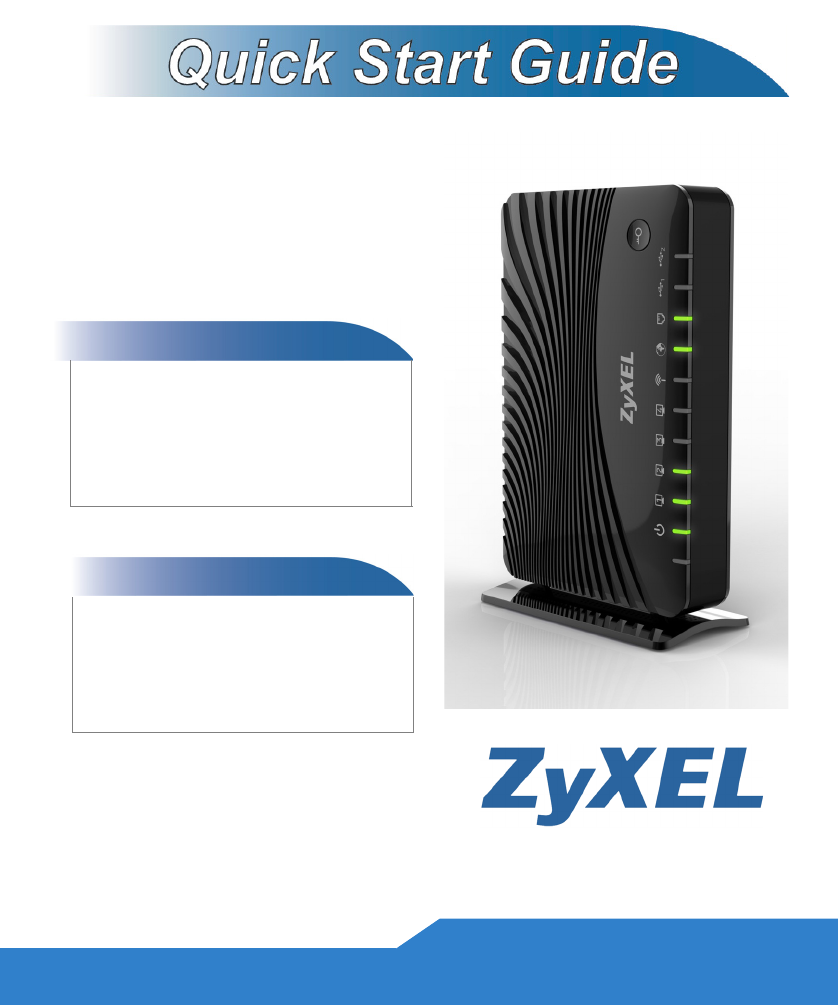
www.zyxel.com
Wireless N ADSL2+ 4-port USB
Gateway
Firmware Version 3.10
Edition 1, 07/2011
P-660HNU-F1
DEFAULT LOGIN DETAILS
IP Address: http://192.168.1.1
Admin Login: User Name: admin
Password: 1234
User Login: User Name: user
Password: 1234
CONTENTS
ENGLISH 3
DEUTSCH 13
FRANÇAIS 25
ITALIANO 37
Copyright 2011
ZyXEL Communications Corporation
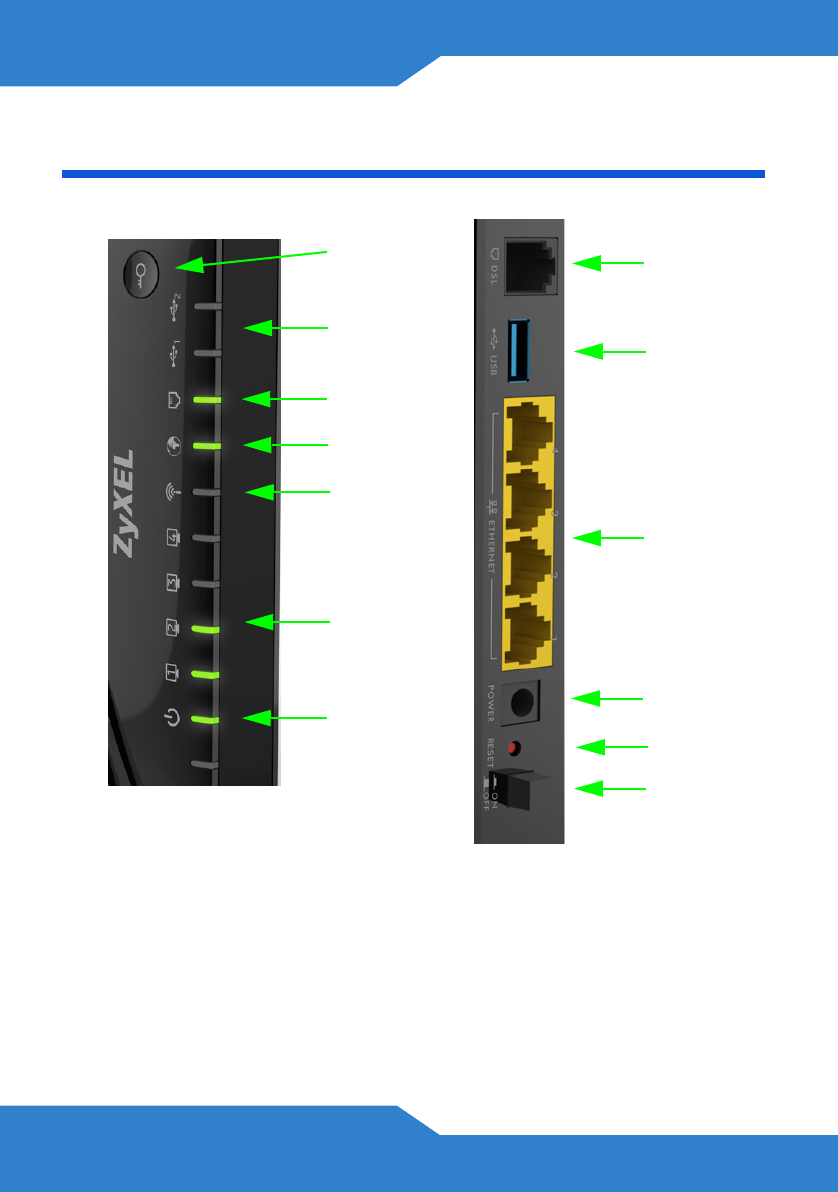
2
Device Panels
WLAN/WPS
ON/OFF
POWER
LED
DSL
INTERNET
LED
WLAN/WPS
LED
ETHERNET
LED
USB
LED
ON/OFF
RESET
POWER
ETHERNET
PORTS
DSL
PORT
USB
PORT
CONNECTOR
SWITCH

3
ENGLISH
Requirements
Make sure you have the following things before you start.
• INTERNET ACCESS: You need an Internet account with an ISP
(Internet Service Provider) and information such as user name,
password, and so on.
• 3G ACCOUNT: You need this if you want to use a 3G connection to
access the Internet. The P-660HNU-F1 can also use this 3G
connection as a backup if the DSL connection fails.
• WEB BROWSER: Internet Explorer 6.0 and later versions, with
JavaScript enabled, or Mozilla Firefox 3 and later versions or Safari
2.0 and later versions. The browser will be used to access the
Internet and/or access the P-660HNU-F1’s Web Configurator.
ENGLISH
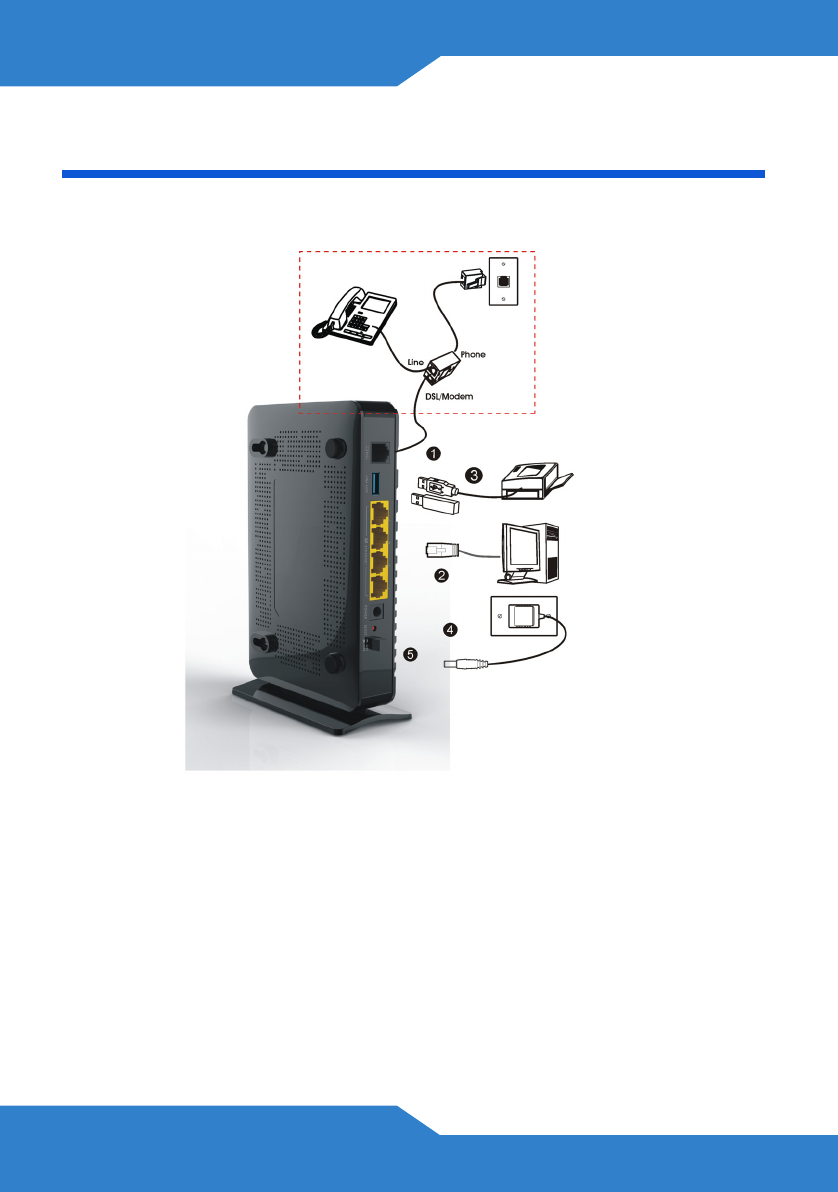
4
Hardware Connections
Remove the P-660HNU-F1’s plastic wrapping before using it.
1. DSL: Use a telephone wire to connect this port to the telephone wall
jack. If you are using a splitter, use a telephone wire to connect this
port to the DSL/MODEM jack on the splitter. Use another telephone
wire to connect the PHONE jack in the splitter to the telephone wall
jack.
2. ETHERNET: If you want a wired connection to the P-660HNU-F1, use
an Ethernet cable to connect a computer to one of these ports for
initial configuration and/or Internet access.
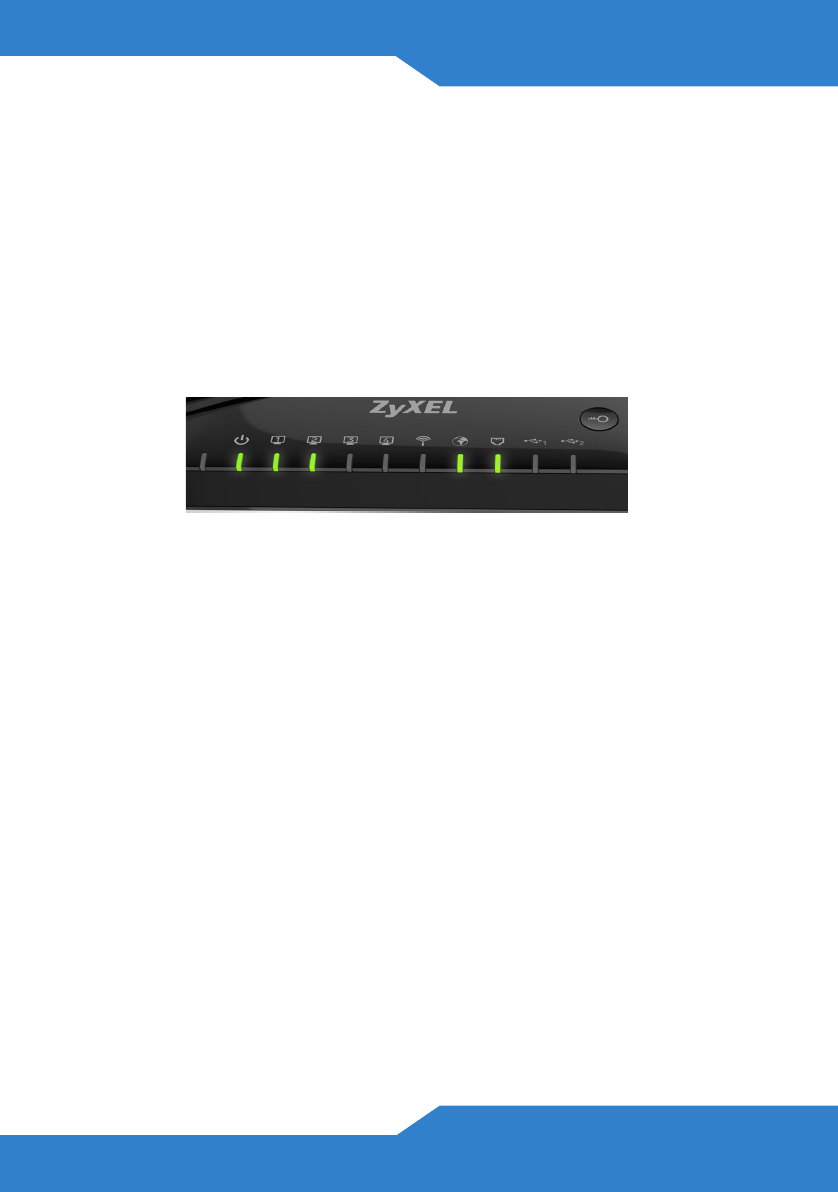
5
ENGLISH
3. USB 2.0: You only need to use this port if you are connecting a USB
storage device, USB printer or a 3G adapter to the P-660HNU-F1.
4. POWER: Use the power adaptor provided with your P-660HNU-F1 to
connect this socket to an appropriate power source.
5. Push the power button to the on position and look at the LEDs (lights)
on the top panel of the P-660HNU-F1.
• The POWER light blinks during start-up and stays on once the P-
660HNU-F1 is ready.
• The ETHERNET light turns on if the corresponding ETHERNET
port is properly connected. If you do not connect a computer
correctly to this port, the ETHERNET light will not turn on.
• The WLAN/WPS stays on when the wireless LAN is ready. The
light will not turn on if the Wireless Connection is not activated.
The ETHERNET and WLAN/WPS lights blink when the P-660HNU-F1 is
sending or receiving data. If the POWER light does not turn on during
start up, try turning the P-660HNU-F1 off, check the connections, wait a
few seconds and then turn it back on. If the problem persists, you may
have a hardware problem and you need to contact your vendor.

6
Internet Access Setup
The DSL and INTERNET lights are on if you have internet access. Open
your web browser and browse to www.zyxel.com. You may be prompted
to enter your username and password.
If one or both of these lights are not on, try turning the P-660HNU-F1 off,
check the connections, wait a few seconds and then turn it back on. If
the DSL light is not on, contact your service provider. If the DSL light is
on but the INTERNET light is not, you need to enter your Internet access
configuration using the Web Configurator - see page 10.
Setting Up a Wireless Connection
If you want to set up a wireless connection using the P-660HNU-F1, use
one of the following methods:
1. Use the wireless SSID (network name) and WPA-PSK encryption key
if the device does not have the WPS logo - see page 7.
2. Use the WPS/WLAN Button if your wireless device has a Wi-Fi
Protected Setup (WPS) logo - see page 9
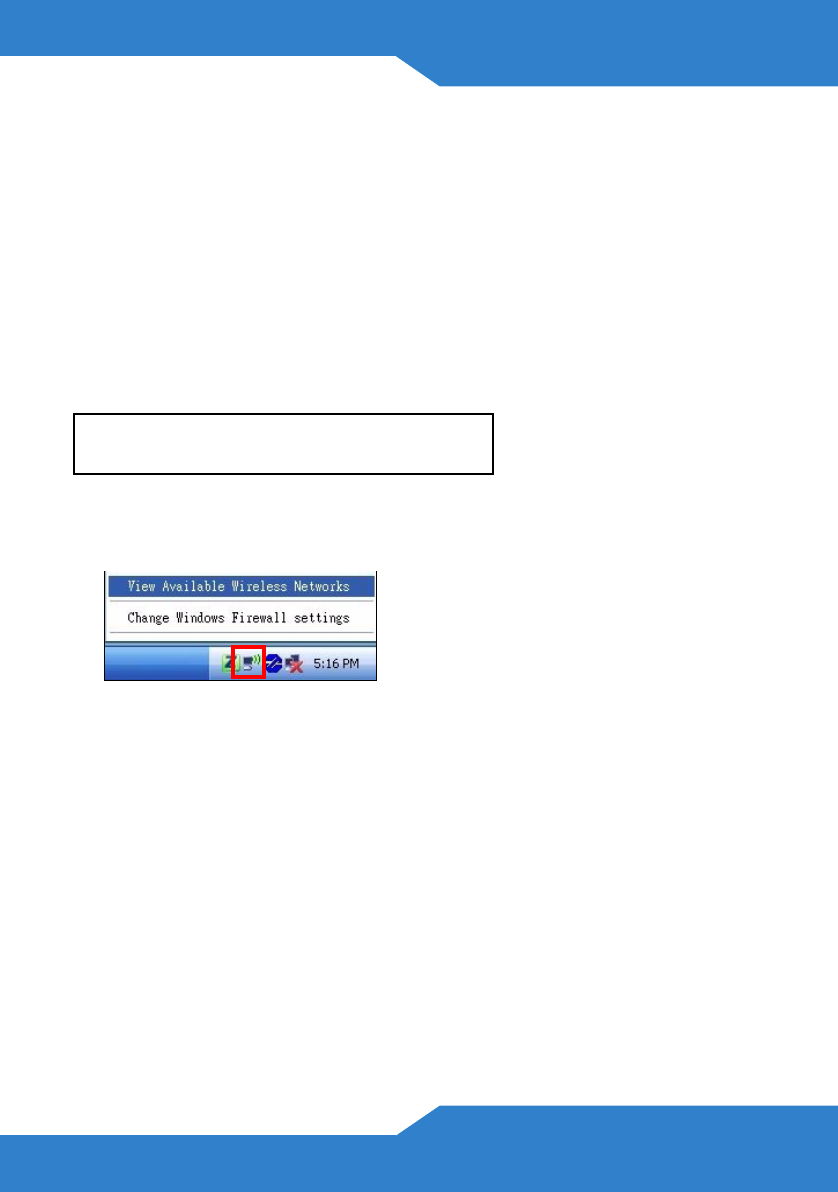
7
ENGLISH
Setting Up a Wireless Connection using the
Information on the Label
The wireless function on your P-660HNU-F1 is enabled by default. Press
the WLAN/WPS button on the P-660HNU-F1’s top panel for 1 second to
turn this function on or off.
To add a wireless client to the network, use the settings found in the rear
panel of the P-660HNU-F1, such as the following:
1. Right-click the wireless adapter icon which appears in the bottom
right of your computer monitor. Click View Available Wireless
Networks.
SSID: Zy_private_R9XP9P
WPA2-PSK: 7WC3R7TVKWK3R
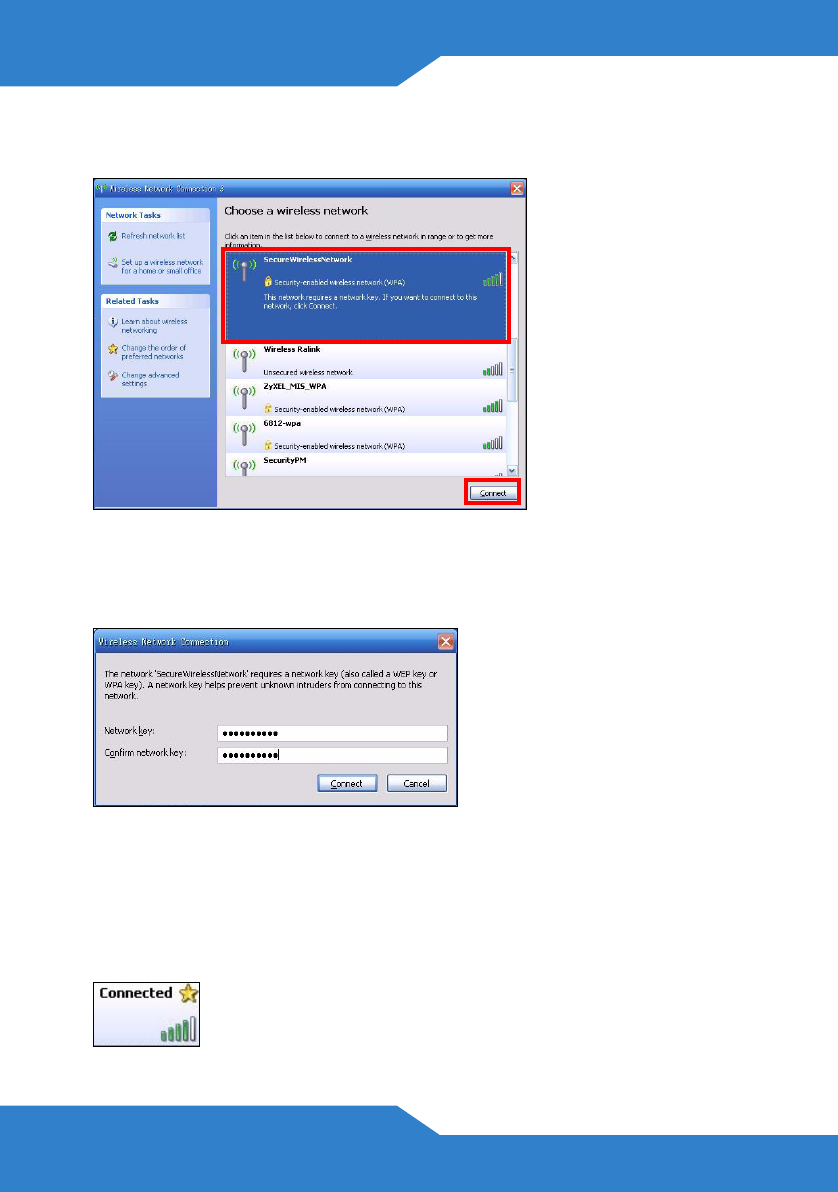
8
2. Select the P-660HNU-F1’s SSID name and click Connect (A). The
SSID “SecureWirelessNetwork” is given here as an example.
3. You are prompted to enter a password. Enter the WPA-PSK
encryption key found in the rear panel of the P-660HNU-F1 and click
Connect.
4. You may have to wait several minutes while your computer connects
to the wireless network.
5. You should now be securely connected wirelessly to the P-660HNU-
F1.
A
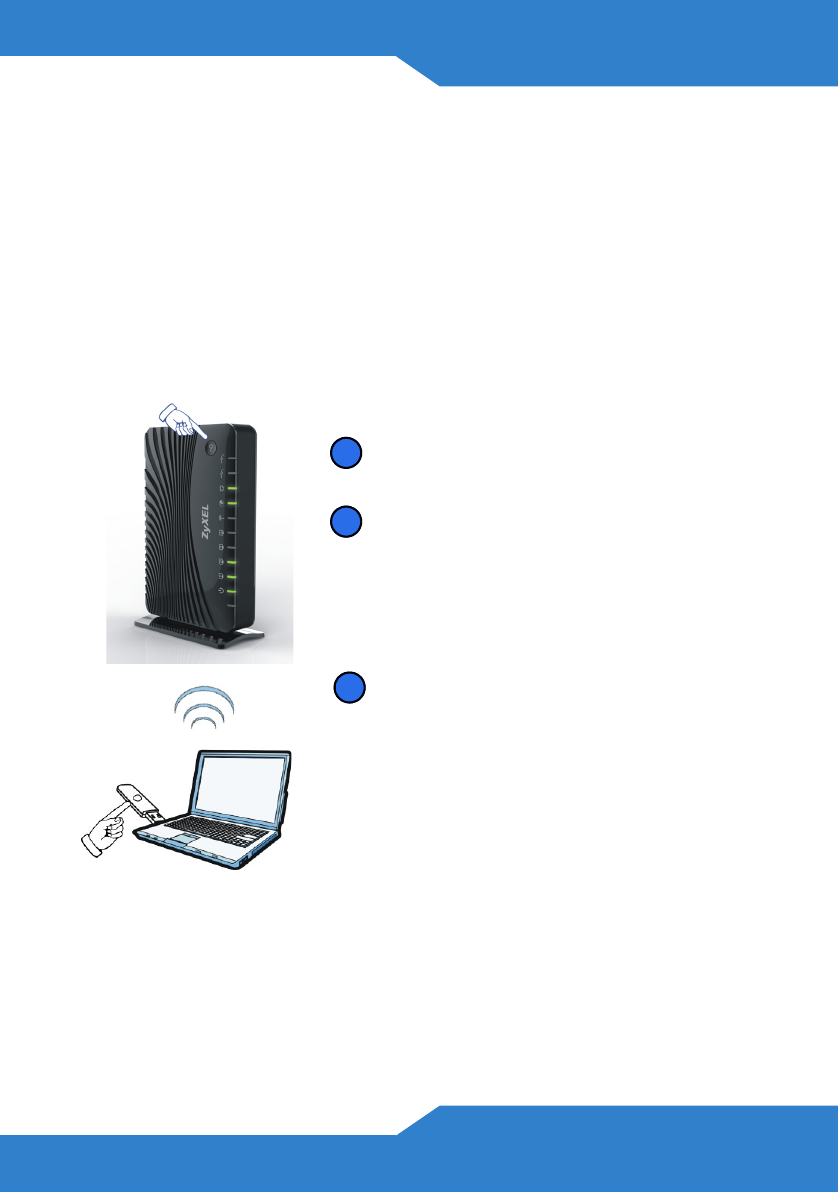
9
ENGLISH
If you cannot connect wirelessly to the P-660HNU-F1, check
that you have selected the correct SSID and entered the
correct security key. If that does not work, ensure that the
WLAN/WPS LED on the front panel is turned on.
Setting Up a Wireless Connection using WPS
Follow these steps to add a WPS-enabled device to the wireless network
using the WLAN/WPS button.
You must use WPS one device at a time with the P-660HNU-F1.
Place the devices you want to connect
near one another.
Press the WLAN/WPS button on top of
the P-660HNU-F1 for more than 5
seconds to turn the WPS function on or
off.
The WLAN/WPS light blinks.
Press the WPS button on a compatible
device within 2 minutes of pressing the
button on the P-660HNU-F1.
The WLAN/WPS light on the P-
660HNU-F1 shines steadily when
connected.
1
2
3
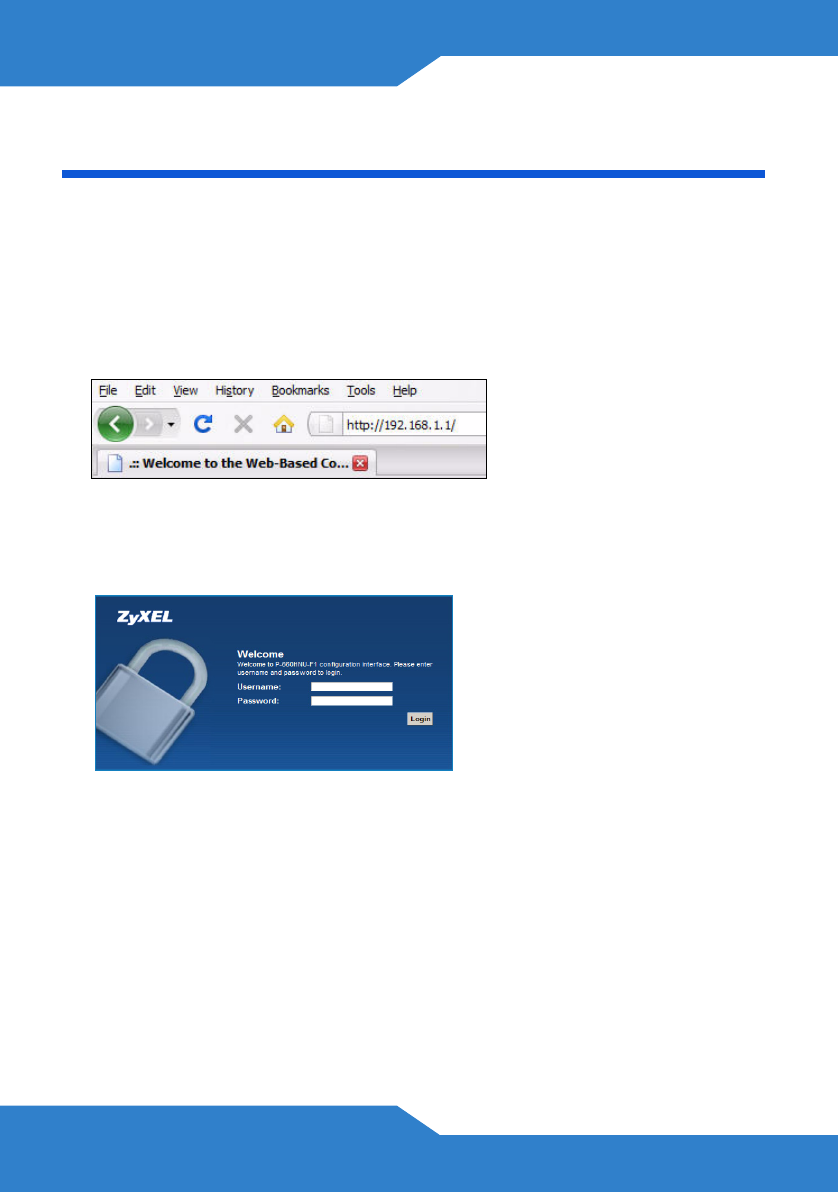
10
The Web Configurator
The Web Configurator is a web browser tool that allows you to configure
the P-660HNU-F1. The computer and the P-660HNU-F1 need to be in
the same IP address range to use this tool.
1. Open your browser and enter http://192.168.1.1 (the P-660HNU-F1's
default IP address) as the address.
2. For administrator login, enter username admin and password 1234
(default). For user login, enter user as the username and 1234 as the
password. Click Login.
If the login screen does not open, make sure you allow web
browser pop-up windows, JavaScript and Java permissions.
Your computer should also be set to get an IP address
automatically from a DHCP server. See your User’s Guide
for more information.
3. If the INTERNET light is off, manually configure the Internet
connection. Click Network Setting, then click on Broadband, and
then click on Add new WAN Interface (Network Setting >
Broadband > Add new WAN Interface).
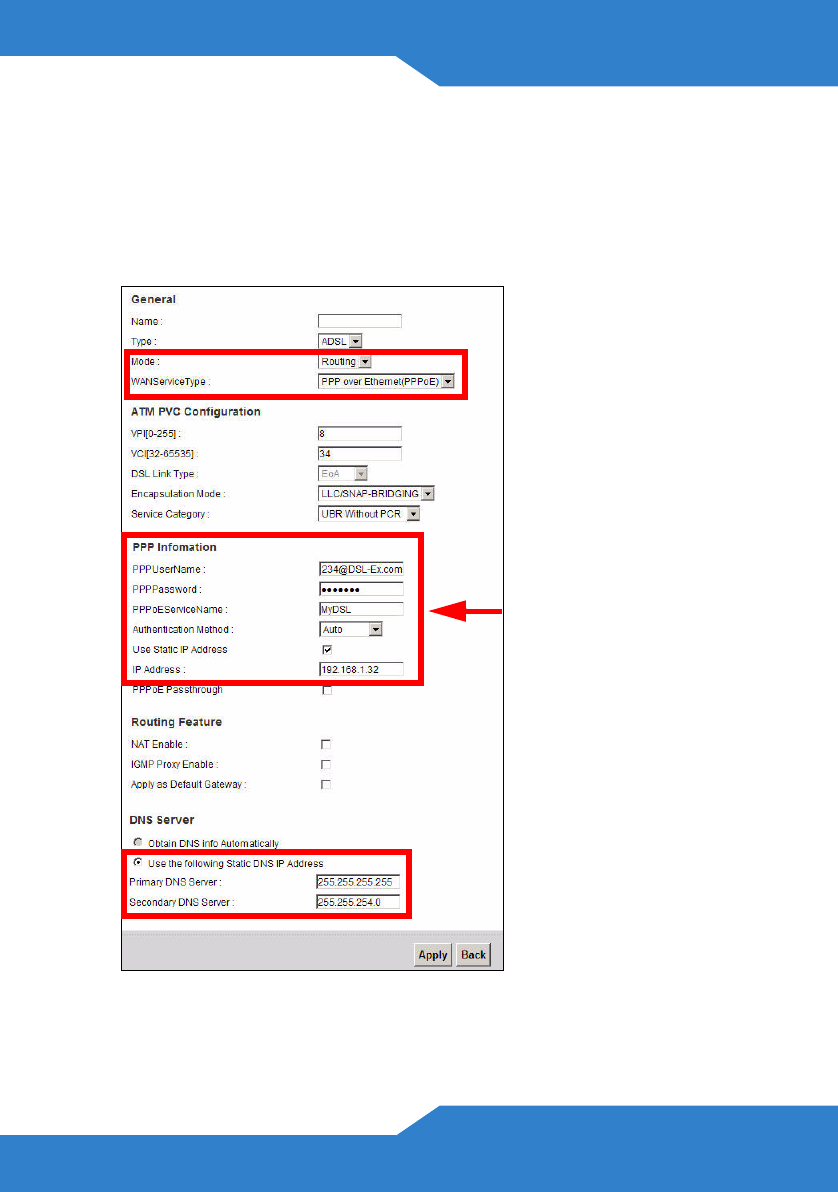
11
ENGLISH
• Select the Internet mode (Routing) and encapsulation (PPPoE)
used by your ISP.
• Type your account username and password.
• Type your static IP address and DNS server if they are not assigned
automatically to your account. Click Apply.
Internet
Account

12
• To configure wireless access, go to Network Setting > Wireless.
• To configure the USB File Sharing feature, go to Network Setting >
Home Networking > File Sharing.
• To configure the USB Printer Server feature, go to Network Setting
> Home Networking > Print Server.
• If you have a 3G account and wish to configure 3G Settings, go to
Network Setting > Broadband > 3G Backup
• To configure WPS using a PIN (Personal Identification Number) and
the Web Configurator, go to Network Setting > Wireless > WPS
See the User’s Guide for details of these and other features of the P-
660HNU-F1
Viewing a Product’s Certifications
1. Go to www.zyxel.com.
2. Select your product from the drop-down list box on the ZyXEL
home page to go to that product's page.
3. Select the certification you wish to view from this page.

DEUTSCH
13
Systemvoraussetzungen
Bevor Sie beginnen, müssen folgende Voraussetzungen erfüllt sein.
• INTERNETZUGRIFF: Sie benötigen ein Internetkonto bei einem
Internetdienstanbieter und die dazugehörigen Daten wie
Benutzername, Passwort usw.
• UMTS-KONTO: Dieses benötigen Sie, wenn Sie über eine UMTS-
Verbindung auf das Internet zugreifen möchten. Der P-660HNU-F1
kann diese UMTS-Verbindung auch ersatzweise verwenden, wenn
die DSL-Verbindung nicht zustande kommt.
• INTERNETBROWSER: Internet Explorer 6.0 mit aktiviertem
JavaScript oder neuere Versionen, Mozilla Firefox 3 und neuere
Versionen oder Safari 2.0 oder neuere Versionen. Der Browser wird
benötigt, um auf das Internet und/oder den Web-Konfigurator des
P-660HNU-F1 zuzugreifen.
DEUTSCH
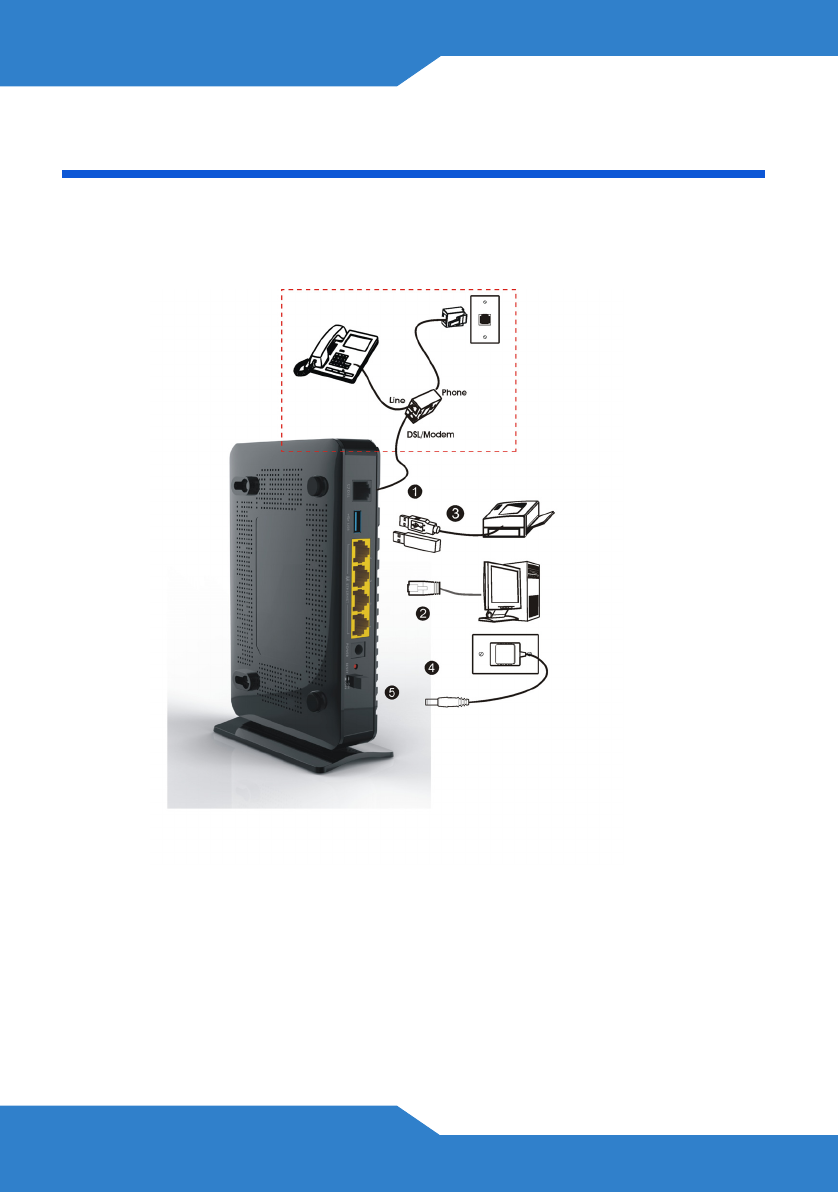
14
Anschließen der Hardware
Nehmen Sie den P-660HNU-F1 aus der Kunststoffverpackung
heraus. Entfernen Sie ggf. auch die Folie von dem Gerät.
1. DSL: Schließen Sie an diesen Port ein Telefonkabel an und
verbinden Sie dieses mit einer Telefonbuchse. Wenn Sie einen
Splitter verwenden, schließen Sie das eine Ende eines Telefonkabels
hier und das andere Ende an die DSL/MODEM-Buchse des Splitters
an. Schließen Sie ein anderes Telefonkabel an die PHONE-Buchse
des Splitters und an die Telefonanschlussdose an.
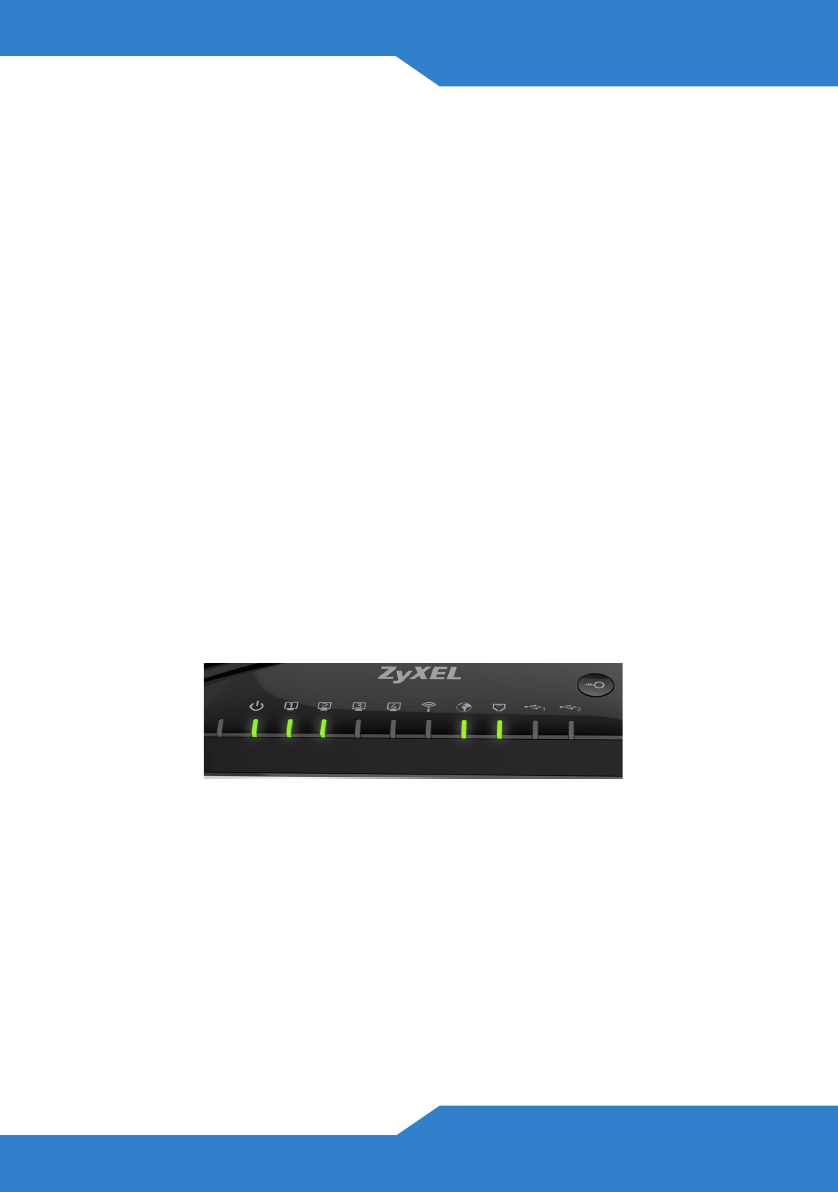
DEUTSCH
15
2. ETHERNET: Für eine kabelgebundene Verbindung zum P-660HNU-
F1 schließen Sie für die Erstkonfiguration und/oder den Internetzugriff
an einen dieser Ports ein von einem Computer kommendes Ethernet-
Kabel an.
3. USB 2.0: Diesen Port benötigen Sie nur, wenn Sie ein USB-
Speichergerät, einen USB-Drucker oder einen UMTS-Adapter an den
P-660HNU-F1 anschließen möchten.
4. ANTENNEN: Befestigen Sie die mitgelieferten Antennen.
5. POWER: Im Lieferumfang des P-660HNU-F1 ist ein Netzadapter
enthalten, den Sie an diesen Anschluss und an eine geeignete
Netzsteckdose anschließen müssen.
6. Drücken Sie die Ein/Aus-Taste in die Position ON. Auf der Oberseite
des P-660HNU-F1 können Sie an den LED-Anzeigen den Status
ablesen.
• Die POWER-LED blinkt, während das Gerät hochfährt, und sie
leuchtet dauerhaft, wenn der P-660HNU-F1 betriebsbereit ist.
• Die ETHERNET-LED beginnt zu leuchten, wenn der entsprechende
ETHERNET-Port richtig angeschlossen ist. Wenn Sie einen
Computer nicht richtig an diesen Port angeschlossen haben,
leuchtet die ETHERNET-LED auch nicht.

16
• Die WLAN/WPS-LED leuchtet dauerhaft, wenn die Wireless-LAN-
Funktion aktiv ist. Die LED leuchtet nicht, wenn die Wireless-
Verbindung nicht aktiviert ist.
Die ETHERNET- und WLAN/WPS-LED blinken, während der P-
660HNU-F1 Daten sendet oder empfängt. Wenn die POWER-LED beim
Hochfahren nicht leuchtet, schalten Sie den P-660HNU-F1 aus, prüfen
Sie die Verbindungen und schalten das Gerät nach einigen Sekunden
wieder an. Wenn das Problem weiterhin bestehen bleibt, liegt die
Ursache möglicherweise bei der Hardware. Wenden Sie sich an Ihren
Händler.
Einrichten des Internetzugriffs
Die DSL- und INTERNET-LED leuchten, wenn eine Verbindung zum
Internet besteht. Öffnen Sie Ihren Internetbrowser und rufen Sie die
Website www.zyxel.com auf. Sie werden aufgefordert, Ihren
Benutzernamen und das Passwort einzugeben.
Wenn eine oder beide LEDs nicht leuchten, schalten Sie den P-
660HNU-F1 aus, prüfen Sie die Verbindungen und schalten das Gerät
nach einigen Sekunden wieder an. Wenn die DSL-LED nicht leuchtet,
wenden Sie sich an Ihren Internetdienstanbieter. Wenn die DSL-LED
leuchtet, die INTERNET-LED jedoch nicht, müssen Sie mit dem Web-
Konfigurator die Internetzugriffskonfiguration aufrufen - siehe Seite 21.

DEUTSCH
17
Einrichten einer
Drahtlosverbindung
Sie können mit dem P-660HNU-F1 auf eine der folgenden Arten eine
Drahtlosverbindung einrichten:
1. Wenn das Gerät kein WPS-Logo hat, verwenden Sie die Wireless
SSID (Netzwerkname) und den WPA-PSK-Schlüssel - siehe Seite
17.
2. Wenn das Drahtlosgerät ein WPS-Logo (Wi-Fi Protected Setup) hat,
verwenden Sie die WPS/WLAN-Taste - siehe Seite 20
Einrichten einer Drahtlosverbindung mit den
Daten des Etiketts
Die Drahtlosfunktion des P-660HNU-F1 ist standardmäßig aktiviert.
Drücken Sie 1 Sekunde lang auf die WLAN/WPS-Taste an der Oberseite
des P-660HNU-F1, um diese Funktion ein- oder auszuschalten.
Um einen Drahtlos-Client zum Netzwerk hinzuzufügen, verwenden Sie
die Einstellungen, die an der Rückseite des P-660HNU-F1 angegeben
sind, z. B.:
SSID: Zy_private_R9XP9P
WPA2-PSK: 7WC3R7TVKWK3R
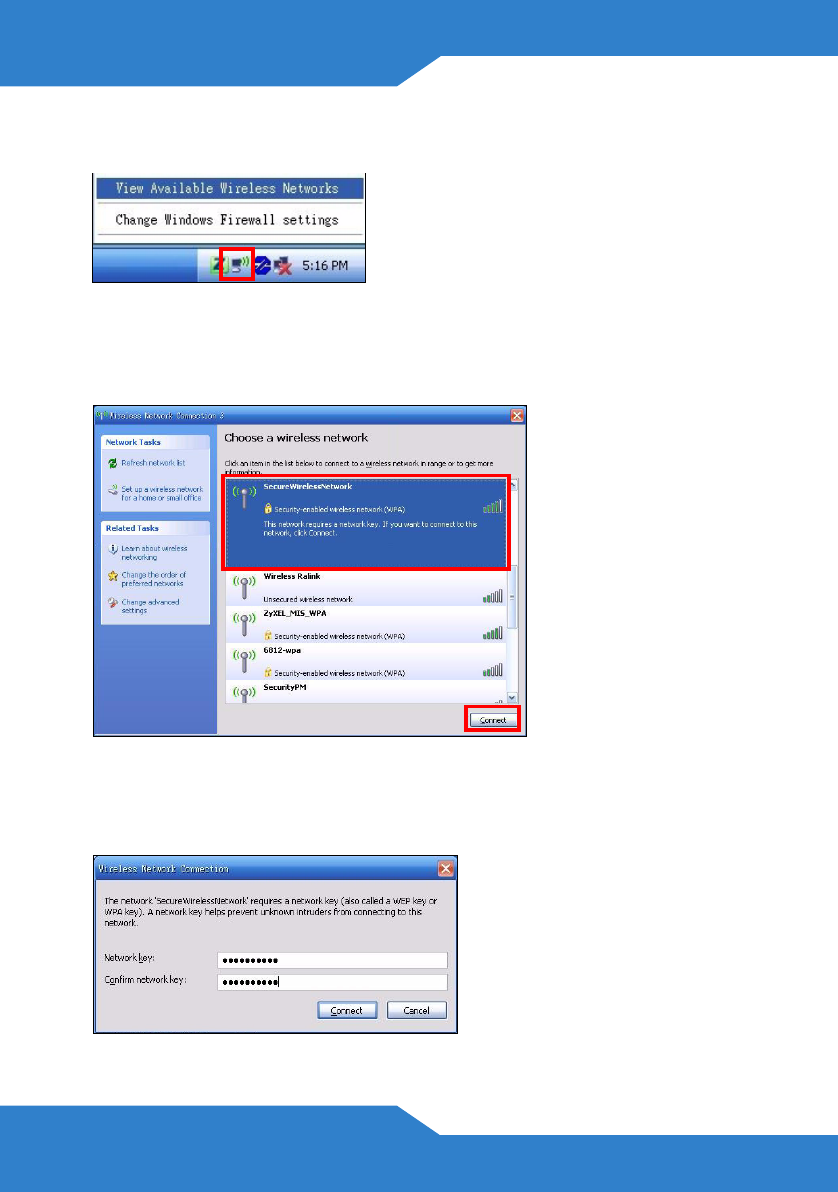
18
1. Klicken Sie auf das Symbol für drahtlose Netzwerke in Ihrem
Betriebssystem wie hier für XP beschrieben.
2. Wählen Sie den SSID-Namen des P-660HNU-F1, und klicken Sie auf
Verbinden (A). Die SSID “SecureWirelessNetwork” ist hier nur als
Beispiel angegeben.
3. Sie werden nun aufgefordert, ein Passwort einzugeben. Geben Sie
den WPA-PSK-Schlüssel ein, der an der Rückseite des P-660HNU-
F1 angegeben ist, und klicken Sie auf Verbinden.
A

DEUTSCH
19
4. Es kann einige Minuten dauern, bis der Computer die Verbindung zum
Drahtlosnetzwerk hergestellt hat.
5. Jetzt besteht eine sichere Drahtlosverbindung zum P-660HNU-F1.
Wenn Sie drahtlos keine Verbindung zum P-660HNU-F1
herstellen können, prüfen Sie, ob Sie die richtige SSID und
den richtigen Schlüssel eingegeben haben. Ist das der Fall,
prüfen Sie, ob die WLAN/WPS-LED an der Vorderseite des
Geräts leuchtet.
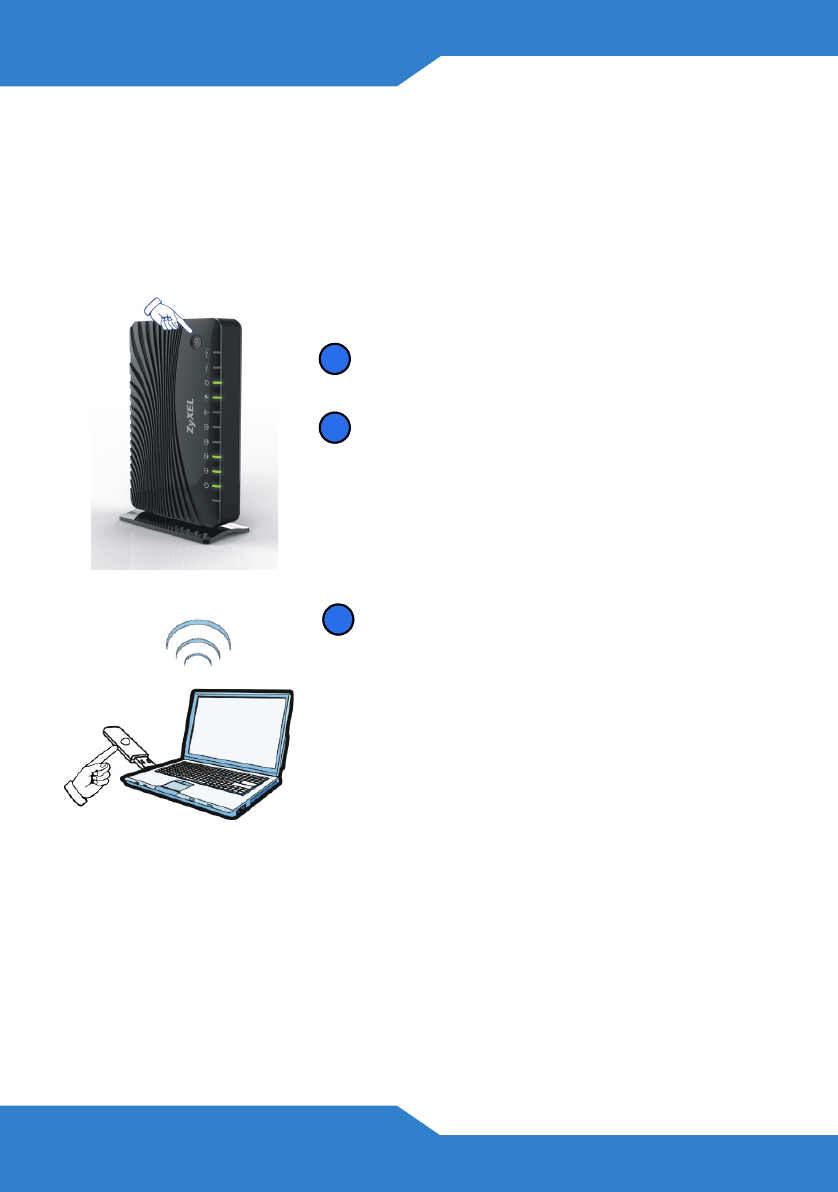
20
Einrichten einer Drahtlosverbindung mit WPS
Führen Sie die folgenden Schritte aus, um ein Gerät mit aktivierter WPS-
Funktion mit der WLAN/WPS-Taste zum Drahtlosnetzwerk hinzuzufügen
.
Mit dem P-660HNU-F1 können Sie jeweils mit nur einem Gerät WPS
verwenden.
Stellen Sie alle Geräte, die
angeschlossen werden sollen, nahe
beieinander.
Drücken Sie länger als 5 Sekunden auf
die WLAN/WPS-Taste auf dem P-
660HNU-F1, um die WPS-Funktion ein-
oder auszuschalten.
Die WLAN/WPS-LED blinkt.
Drücken Sie innerhalb von 2 Minuten,
nachdem Sie auf die Taste des P-
660HNU-F1 gedrückt haben, auf die
WPS-Taste des kompatiblen Geräts.
Sobald die Verbindung besteht, leuchtet
die WLAN/WPS-LED des P-660HNU-
F1 dauerhaft.
1
2
3
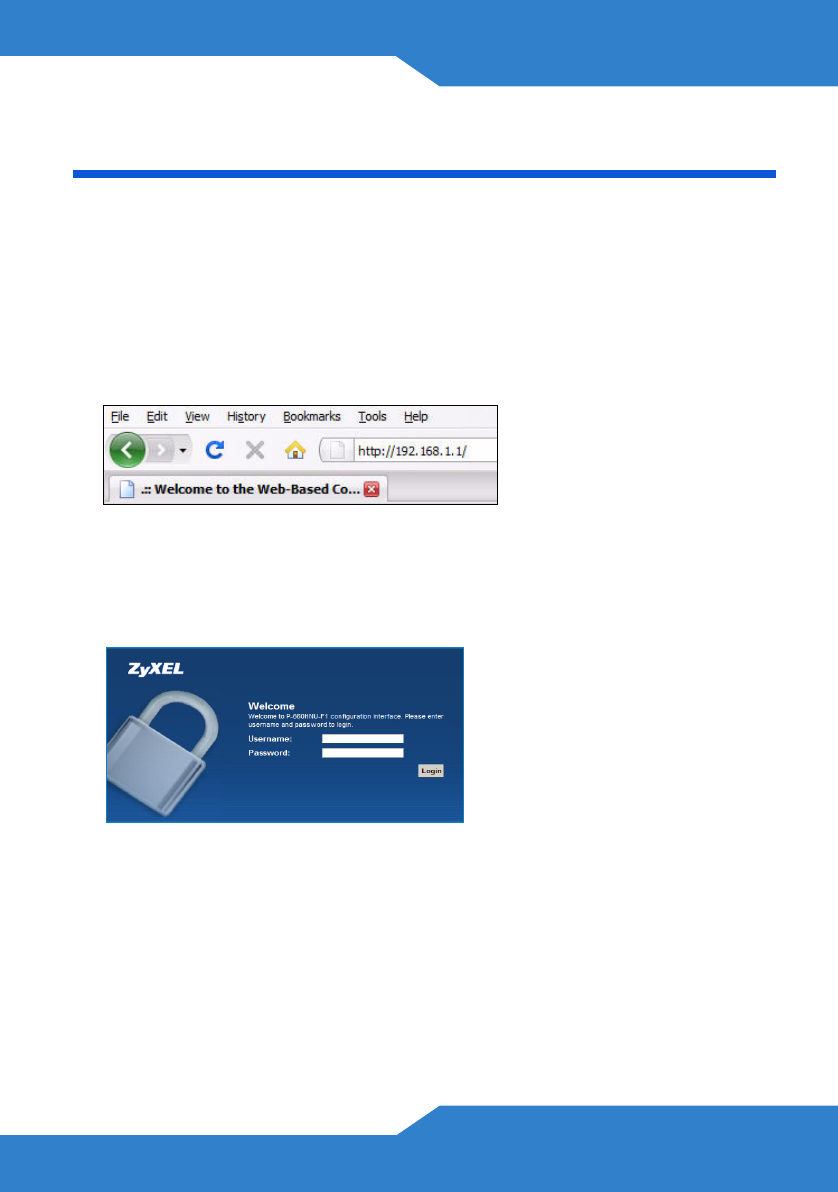
DEUTSCH
21
Der Web-Konfigurator
Der Web-Konfigurator ist ein Internetbrowser-Tool, mit dem Sie den P-
660HNU-F1 konfigurieren können. Der Computer und der P-660HNU-F1
müssen sich im selben IP-Adressbereich befinden, damit Sie dieses Tool
verwenden können.
1. Öffnen Sie Ihren Browser, und geben Sie als Adresse http://
192.168.1.1 (die IP-Standardadresse des P-660HNU-F1) ein.
2. Geben Sie für die Anmeldung als Administrator den Benutzernamen
admin und das Passwort 1234 (Standard) ein. Wenn Sie sich als
Benutzer anmelden, geben Sie als Benutzernamen user und als
Passwort 1234 ein. Klicken Sie auf Login (Anmelden).
Sollte das Anmeldefenster nicht angezeigt werden, stellen
Sie sicher, dass Ihr Internet-Browser Pop-up-Fenster,
JavaScript und Java zulässt. Der Computer sollte außerdem
so eingestellt sein, dass er eine IP-Adresse automatisch von
einem DHCP-Server bezieht. Weitere Informationen finden
Sie im Benutzerhandbuch.

22
3. Wenn die INTERNET-LED nicht leuchtet, müssen Sie die
Internetverbindung manuell konfigurieren. Klicken Sie auf Network
Setting (Netzwerk Einstellungen) und dann auf Broadband
(Breitband). Klicken Sie auf Add new WAN Interface (neuen WAN
Anschluss hinzufügen)
• Wählen Sie den Internetmodus (Routing) und den WAN Service
Typ (meist PPPoE) Ihres Internetdienstanbieters.
• Geben Sie den Benutzernamen und das Passwort Ihres Kontos ein.
• Falls Ihr Internetdienstanbiter die Nutzung einer statischen IP bzw,
DNS Servers vorgibt, so geben Sie diese Daten bitte auch ein.
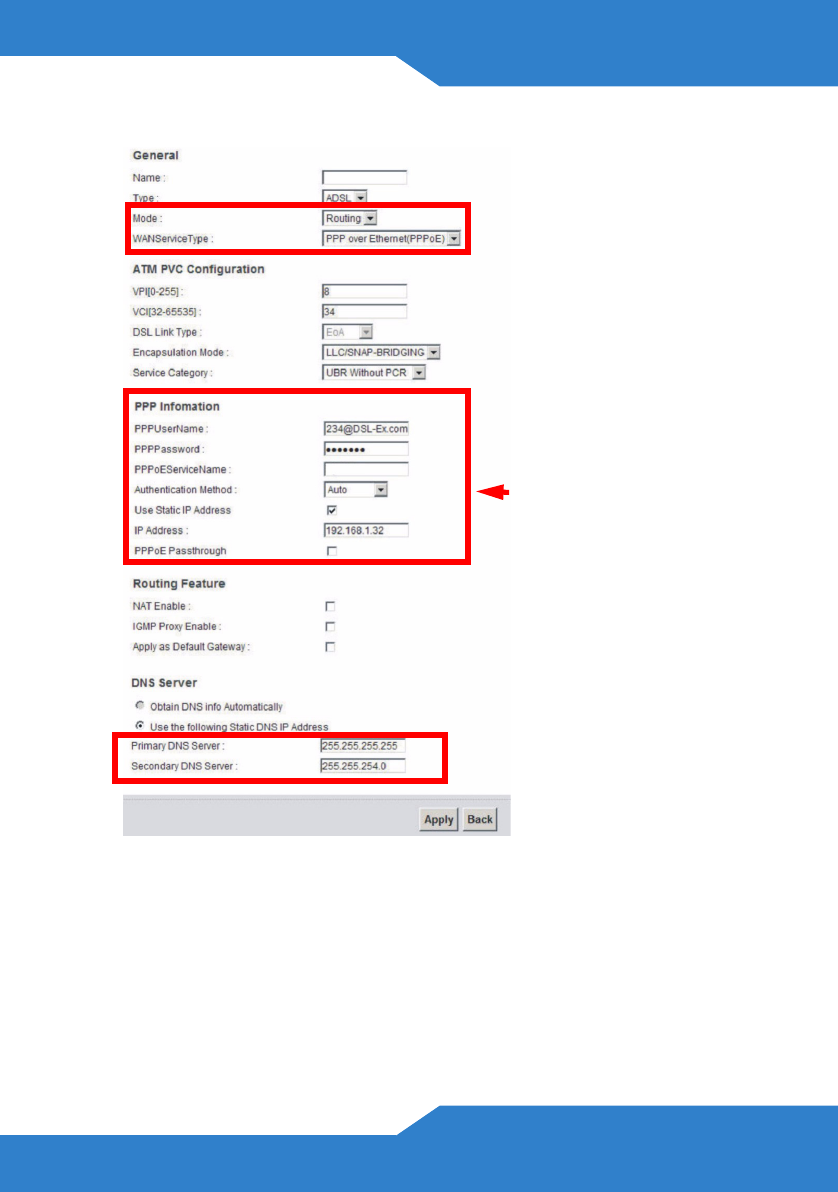
DEUTSCH
23
Klicken Sie auf Apply (Übernehmen).
• Um den Drahtloszugriff zu konfigurieren, gehen Sie zu Network
Setting > Wireless (Netzwerk Einstellung > WLAN).
• Um die USB-Dateifreigabefunktion zu konfigurieren, gehen Sie zu
Network Setting > Home Networking > File Sharing (Netzwerk
Einstellung > Heimnetzwerk > Dateifreigaben).
Internet
Konto

24
• Um die USB-Druckerserverfunktion zu konfigurieren, gehen Sie zu
Network Setting > Home Networking > Print Server (Netzwerk
Einstellung > Heimnetzwerk > Drucker Server).
• Wenn Sie ein UMTS-Konto haben und die UMTS-Einstellungen
konfigurieren möchten, gehen Sie zu Network Setting >
Broadband > UMTS Backup (Netzwerk Einstellung > Breitband >
UMTS Backup).
• Um WPS mit einer PIN (Persönliche Identifikationsnummer) und
dem Web-Konfigurator zu konfigurieren, gehen Sie zu Network
Setting > Wireless > WPS (Netzwerk Einstellung > WLAN >
WPS).
Weitere Informationen zu diesen und anderen Funktionen des P-
660HNU-F1 finden Sie im Benutzerhandbuch.
Produktzertifizierungen
1. Rufen Sie die Seite www.zyxel.com auf.
2. Wählen Sie Ihr Produkt aus der drop-down Liste in dem Feld
auf der ZyXEL Homepage aus und gehen Sie auf diese
Produktseite.
3. Wählen Sie die Zertifizierung, die Sie sehen möchten, auf
dieser Seite aus.

25
FRANÇAIS
Configuration requise
Vérifiez les éléments suivants avant de commencer.
• ACCÈS INTERNET: Vous avez besoin d'un compte Internet fourni
par un fournisseur de service Internet (FSI) et des informations
d'identification comme le nom d'utilisateur, le mot de passe, etc.
• COMPTE 3G: Ce compte est nécessaire si vous utilisez une
connexion 3G pour accéder à Internet. Le P-660HNU-F1 peut
également utiliser cette connexion 3G comme connexion de
secours si la connexion DSL est interrompue.
• NAVIGATEUR WEB: Internet Explorer 6.0 et les versions
ultérieures, avec JavaScript, ou Mozilla Firefox 3 et les versions
ultérieures, ou Safari 2.0 et les versions ultérieures. La navigateur
est utilisé pour accéder à Internet et/ou au P-660HNU-F1Web
Configurator (Configurateur Web).
FRANÇAIS
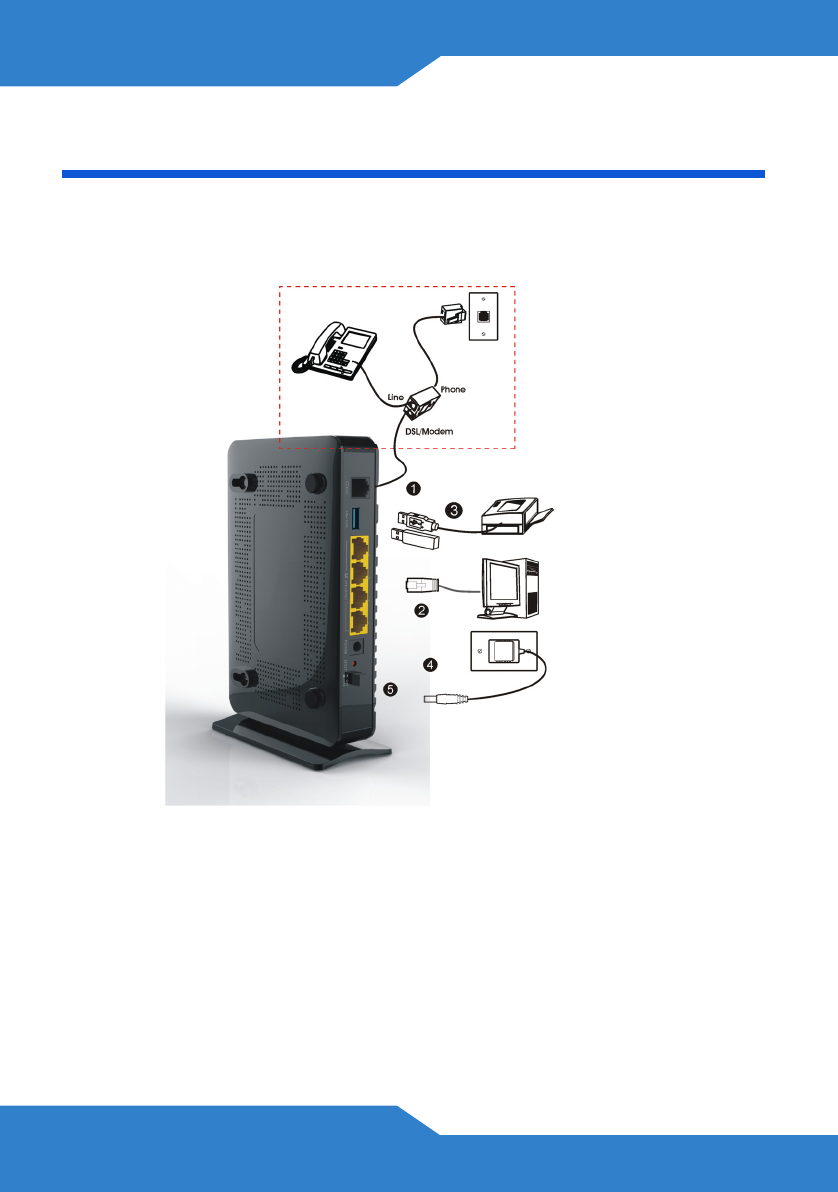
26
Connexions matérielles
Retirez le P-660HNU-F1 plastique d'emballage avant de
l'utiliser.
1. DSL: Utilisez un fil téléphone pour connecter ce port à une prise
téléphonique. Si vous utilisez un séparateur, utilisez un cordon de
téléphone pour connecter ce port au connecteur DSL/MODEM du
séparateur. Utilisez un autre fil de téléphone pour connecter la prise
PHONE (TÉLÉPHONE) du séparateur à la prise téléphonique
murale.
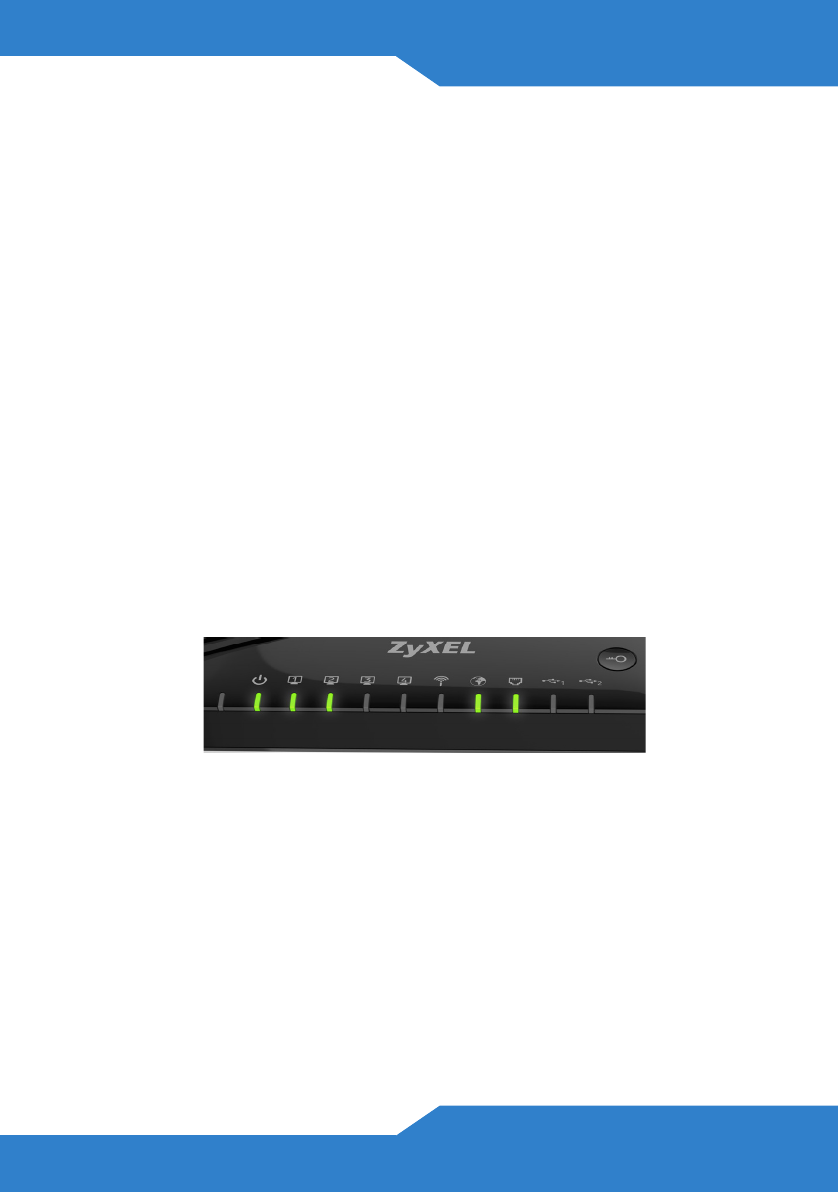
27
FRANÇAIS
2. ETHERNET: Pour une connexion filaire au P-660HNU-F1, utilisez un
câble Ethernet pour connecter l'ordinateur à un de ces ports pour
une configuration initiale et/ou un accès Internet.
3. USB 2.0: Ce port n'est nécessaire que si vous souhaitez connecter
un périphérique de stockage USB, une imprimante USB ou un
adaptateur 3G au P-660HNU-F1.
4. ANTENNES: Pour connecter les antennes fournies.
5. ALIMENTATION: Utilisez l'adaptateur d'alimentation fourni avec votre
P-660HNU-F1 pour connecter la prise à une source d'alimentation
adaptée.
6. Mettez l'interrupteur d'alimentation sur la position ON (MARCHE) et
observez les voyants lumineux sur le panneau supérieur du P-
660HNU-F1.
• Le voyant POWER (ALIMENTATION) clignote au démarrage et
reste vert une fois que le P-660HNU-F1 est prêt
• Chaque voyant ETHERNET s'allume si le port ETHERNET
correspondant est correctement connecté. Si l'ordinateur n'est pas
correctement connecté à ce port, le voyant ETHERNET ne
s'allumera pas.
• Le voyant WLAN/WPS s'allume quand le LAN sans fil est prêt. Le
voyant ne s'allumera pas si la connexion sans fil n'est pas activée.

28
Les voyants ETHERNET et WLAN/WPS clignotent lorsque le P-
660HNU-F1 envoie ou reçoit des données. Si le voyant POWER
(ALIMENTATION) ne s'allume pas au moment du démarrage, éteignez
le P-660HNU-F1, vérifiez les connexions, patientez quelques secondes,
puis rallumez l'appareil. Si le problème persiste, vous avez
probablement un problème de matériel. Veuillez contacter votre vendeur.
Installation de l'accès à Internet
Les voyants DSL et INTERNET s'allument lorsque l'accès à Internet est
établi. Ouvrez votre navigateur Web et allez sur le site www.zyxel.com.
Vous serez invité à saisir vos nom d'utilisateur et mot de passe.
Si un de ces voyants (ou les deux) ne s'allume pas, éteignez le P-
660HNU-F1, vérifiez les connexions, patientez quelques secondes, puis
rallumez l'appareil. Si le voyant DSL n'est pas allumé, contactez votre
fournisseur de service. Si le voyant DSL est allumé, mais que le voyant
INTERNET ne l'est pas, entrez votre configuration d'accès Internet en
utilisant le Web Configurator (Configurateur Web) - voir page 33.
Configurer une connexion sans
fil
Pour configurer une connexion sans fil avec le P-660HNU-F1, utilisez
l'une des méthodes suivantes:
1. Utilisez le SSID sans fil (nom du réseau) et la clé de cryptage WPA-
PSK si l'appareil n'a pas le logo WPS - voir page 29.
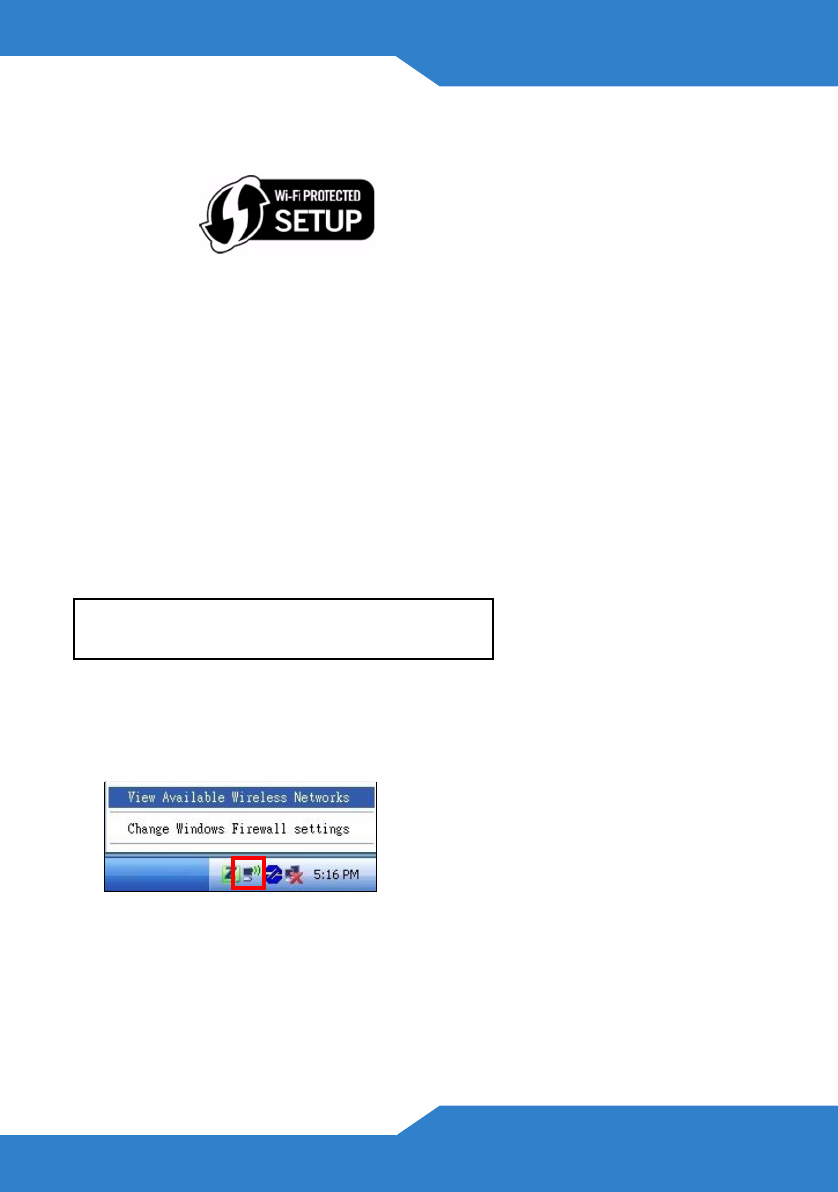
29
FRANÇAIS
2. Utilisez le bouton WPS/WLAN si votre appareil sans fil a le logo
WPS (Wi-Fi Protected Setup) - voir page 32
Configurer une connexion sans fil en utilisant
les informations sur l'étiquette
La fonction sans fil sur votre P-660HNU-F1 est activée par défaut.
Appuyez sur le bouton WLAN/WPS sur le panneau supérieur du P-
660HNU-F1 pendant 1 seconde pour activer ou désactiver cette
fonction.
Pour ajouter un client sans fil au réseau, utilisez les paramètres indiqués
sur le panneau arrière du P-660HNU-F1, comme suit:
1. Cliquez avec le bouton droit sur l'icône de l'adaptateur sans fil qui
apparaît en bas à droite de l'écran de votre ordinateur. Cliquez sur
View Available Wireless Networks (Afficher les réseaux sans fils
disponibles).
SSID : Zy_private_R9XP9P
WPA2-PSK: 7WC3R7TVKWK3R
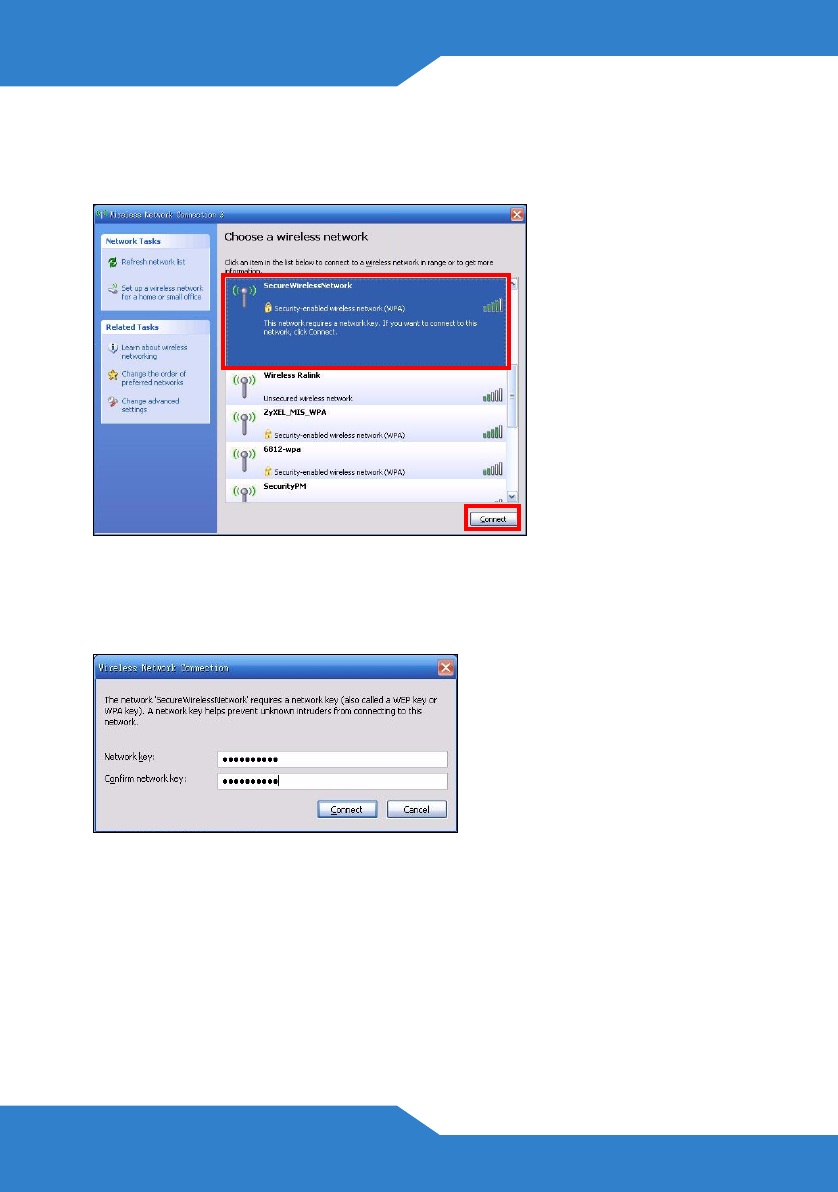
30
2. Sélectionnez le nom SSID du P-660HNU-F1 et cliquez sur Connect
(Connecter) (A). Le SSID SecureWirelessNetwork
(RéseauSansfilSécurisé) est donné ici en exemple.
3. Vous êtes invité à entrer un mot de passe. Entrez la clé de cryptage
WPA-PSK indiquée sur le panneau arrière du P-660HNU-F1 et
cliquez sur Connect (Connecter).
4. Patientez quelques minutes pendant la connexion de votre ordinateur
au réseau sans fil.
A

31
FRANÇAIS
5. Vous devriez maintenant être connecté de façon sécurisée et sans fil
au P-660HNU-F1.
Si vous n'arrivez pas à établir une connexion sans fil avec le
P-660HNU-F1, vérifiez que vous avez sélectionné le bon
SSID et saisi la bonne clé de sécurité. Si cela ne fonctionne
pas, vérifiez que le voyant WLAN/WPS est allumé sur le
panneau supérieur.
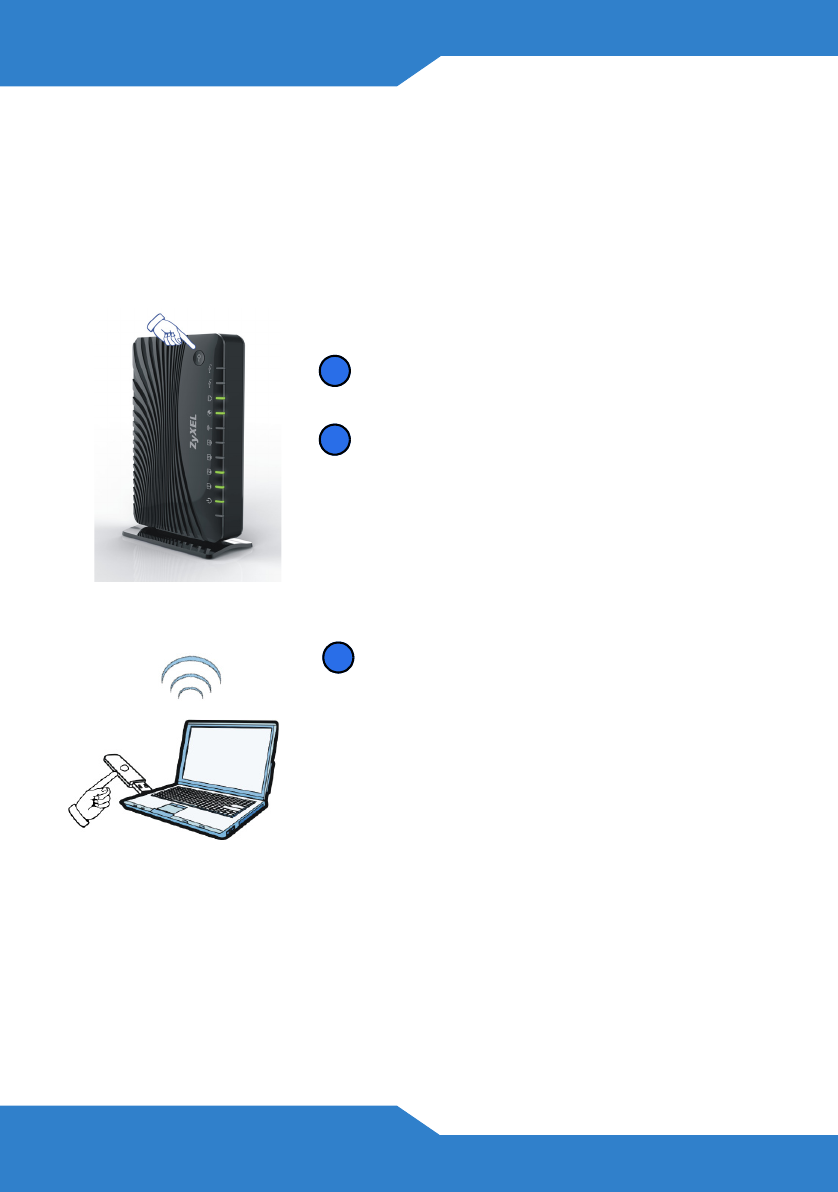
32
Configurer une connexion sans fil en utilisant
le WPS
Suivez ces étapes pour ajouter un périphérique WPS au réseau sans fil
en utilisant le bouton WLAN/WPS.
Vous devez utiliser un seul appareil WPS à la fois avec le P-660HNU-F1.
Rapprochez les uns des autres les
périphériques que vous voulez
connecter.
Appuyez sur le bouton WLAN/WPS en
haut du P-660HNU-F1 pendant plus de
5 secondes pour activer ou désactiver
la fonction WPS.
Le voyant lumineux WLAN/WPS
clignote.
Après avoir appuyé sur bouton du P-
660HNU-F1 vous avez jusqu'à 2
minutes pour appuyer sur le bouton
WPS du périphérique compatible.
Le voyant lumineux WLAN/WPS P-
660HNU-F1s'allume de manière
continue une fois la connexion établie.
1
2
3
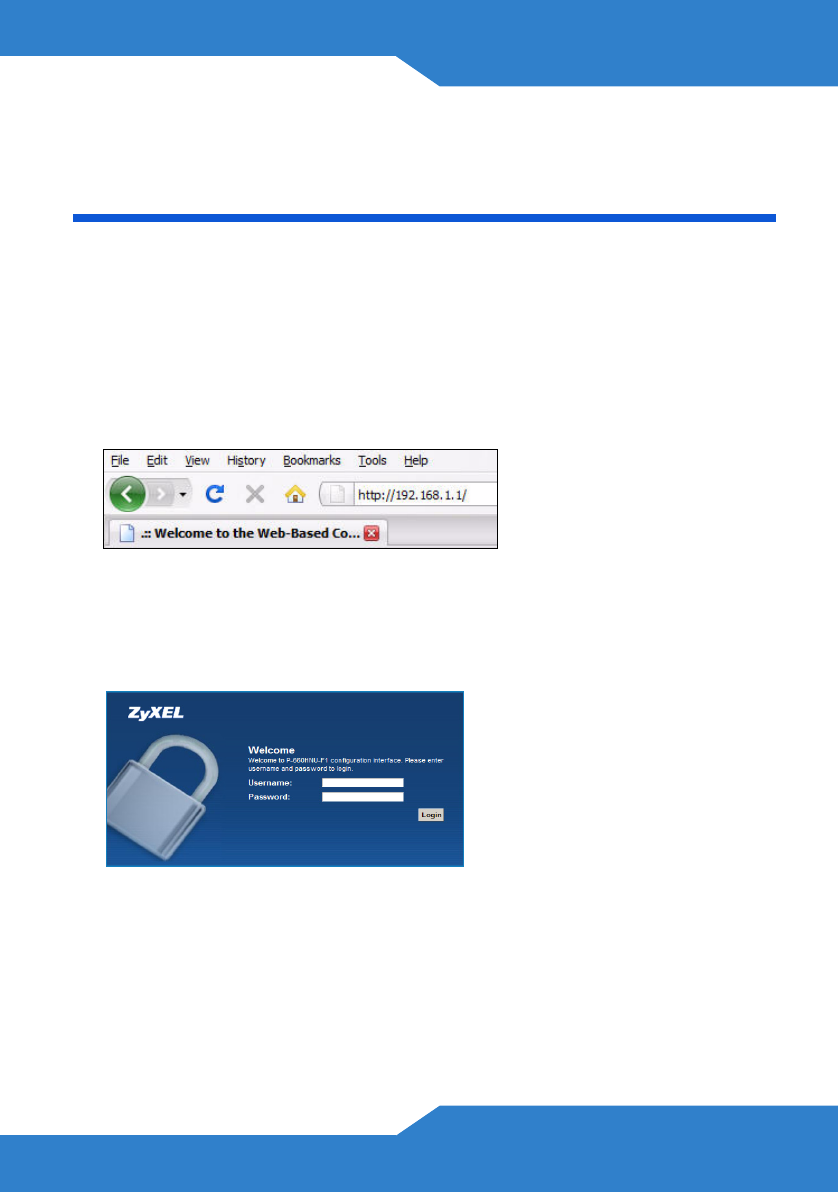
33
FRANÇAIS
Le Web Configurator
(Configurateur Web)
Le Web Configurator (Configurateur Web) est un outil de navigation Web
qui vous permet de configurer le P-660HNU-F1. L'ordinateur et le P-
660HNU-F1 doivent avoir la même plage d'adresse IP pour utiliser cet
outil.
1. Ouvrez votre navigateur et entrez l'adresse http://192.168.1.1
(l'adresse IP par défaut du P-660HNU-F1).
2. Pour la connexion de l'administrateur, entrez le nom d'utilisateur
admin et le mot de passe 1234 (par défaut). Pour la connexion
d'utilisateur, entrez le nom d'utilisateur utilisateur et le mot de passe
1234. Cliquez sur Login (Ouvrir une session).
Si l'écran d'ouverture de session n'apparaît pas, vérifiez que
les fenêtres contextuelles du Web sont autorisées, et vérifiez
les permissions de JavaScript et Java. De plus, votre
ordinateur doit être paramétré de façon à obtenir
automatiquement une adresse IP fournie par un serveur
DHCP. Consultez votre guide de l'utilisateur pour plus
d'informations.

34
3. Si le voyant INTERNET est éteint, configurez manuellement la
connexion Internet. Cliquez sur Network Setting (Configuration
réseau), et cliquez sur Broadband (Large bande), puis cliquez sur
Add new WAN Interface (Network Setting > Broadband > Add
new WAN Interface) (Configuration réseau > Large bande > Ajouter
une nouvelle interface WAN).
• Sélectionnez le mode Internet (Routing (Routage)) et
l'encapsulation (PPPoE) utilisé par votre FSI (fournisseur de
service Internet).
• Tapez le nom d'utilisateur et le mot de passe de votre compte.
• Tapez l'adresse IP statique et l'adresse du serveur DNS si elles ne
sont pas attribuées automatiquement à votre compte. Cliquez sur
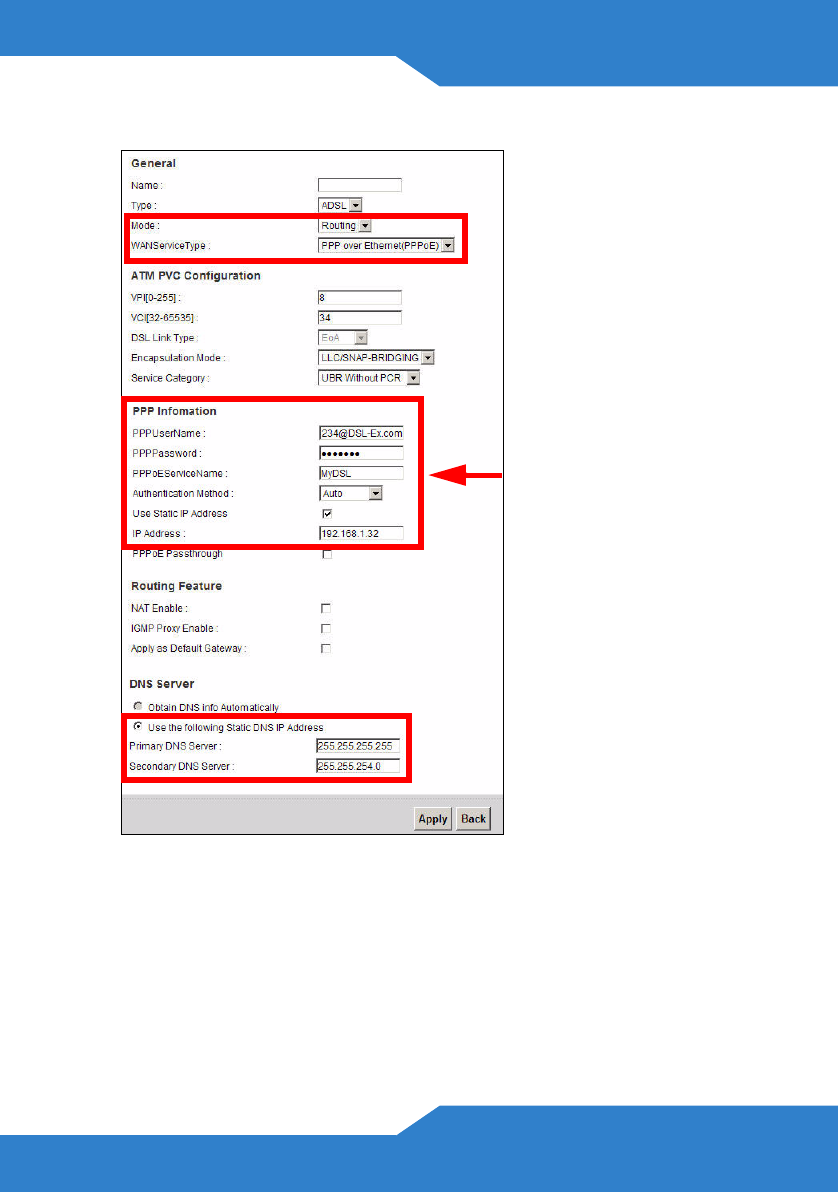
35
FRANÇAIS
Apply (Appliquer)
• Pour configurer un accès sans fil, allez à Network Setting >
Wireless (Configuration réseau > Sans fil).
• Pour configurer la fonction USB File Sharing (Partage de fichier
USB), allez à Network Setting > Home Networking > File
Internet
Compte

36
Sharing (Configuration réseau > Réseau domestique > Partage de
fichier).
• Pour configurer la fonction USB Printer Server (Serveur
d'imprimante USB), allez à Network Setting > Home Networking
> Print Server. (Configuration réseau > Réseau domestique >
Serveur d'imprimante).
• Si vous avez un compte 3G et que vous souhaitez configurer les
paramètres 3G, allez à Network Setting > Broadband > 3G
Backup (Configuration réseau > Large bande > Connexion de
secours 3G)
• Pour configurer le WPS en utilisant un code PIN (Personal
Identification Number) et le Web Configurator (Configurateur Web),
allez à Network Setting > Wireless > WPS (Configuration réseau
> Sans fil > WPS)
Consultez le guide d'utilisateur pour plus d'informations concernant ces
fonctions et d'autres fonctions du P-660HNU-F1
Afficher la certification d'un produit
1. Allez à www.zyxel.com.
2. Sélectionnez votre produit dans la liste déroulante dans la
page d'accueil de ZyXEL pour accéder à la page de ce
produit.
3. Sélectionnez la certification que vous désirez consulter dans
cette page.

37
ITALIANO
Requisiti
Prima di iniziare assicurarsi di avere disponibile quanto elencato di
seguito.
• ACCESSI A INTERNET: è necessario disporre di un account
Internet con un fornitore di accesso (ISP, Internet Service Provider)
e delle informazioni correlate quali nome utente, password e così
via.
• ACCOUNT 3G: questo account è necessario se si desidera
utilizzare una connessione 3G per accedere a Internet. Il P-
660HNU-F1 è anche in grado di utilizzare questa connessione 3G
come connessione di riserva in caso di problemi con la
connessione DSL.
• BROWSER WEB: Internet Explorer 6.0 o versione successiva con
JavaScript attivato, Mozilla Firefox 3 o versione successiva, oppure
Safari 2.0 o versione successiva. Il browser sarà utilizzato per
accedere a Internet e/o per accedere allo Strumento di
configurazione Web del P-660HNU-F1.
ITALIANO
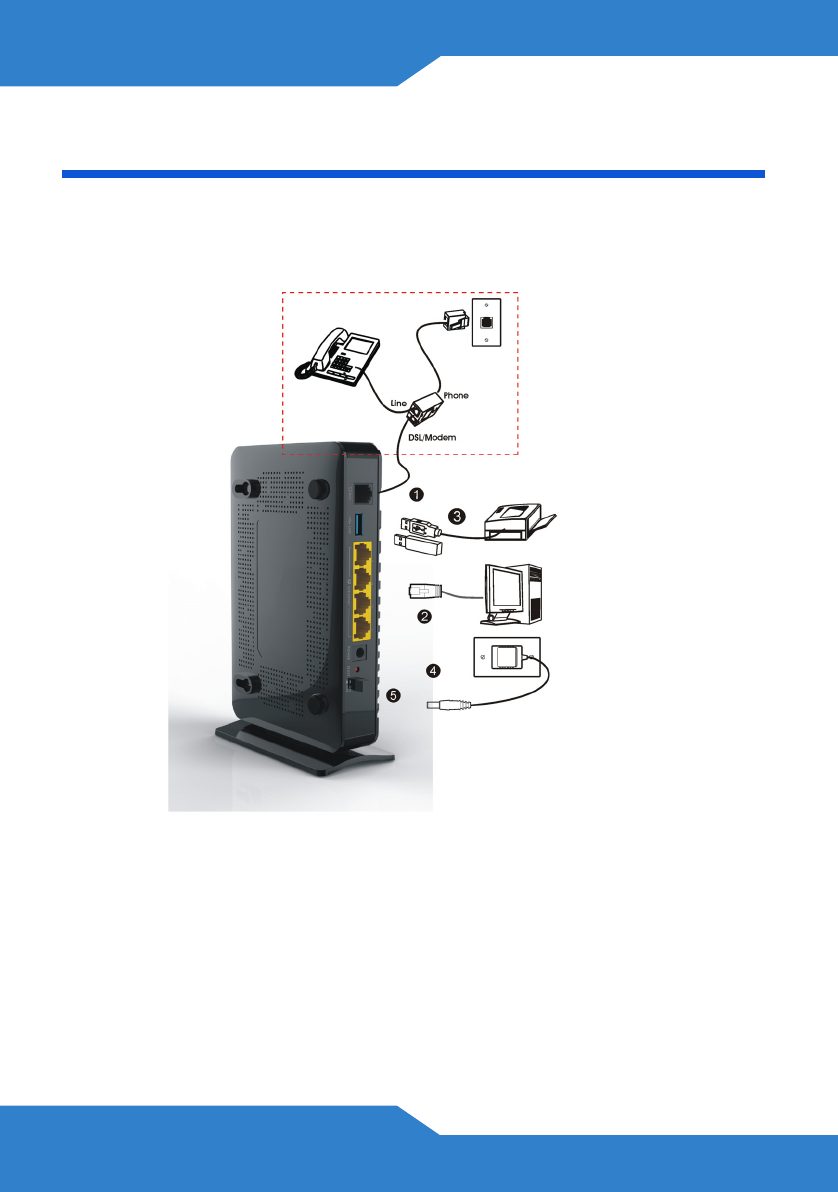
38
Collegamenti hardware
Rimuovere l'imballo di plastica del P-660HNU-F1 prima di
utilizzarlo.
1. DSL: utilizzare un cavo telefonico per connettere questa porta alla
presa del telefono. Se si utilizza uno splitter, utilizzare un cavo
telefonico per collegare questa porta al jack DSL/MODEM sullo
splitter. Utilizzare un altro cavo telefonico per collegare il jack PHONE
(telefono) dello splitter alla presa telefonica a muro.
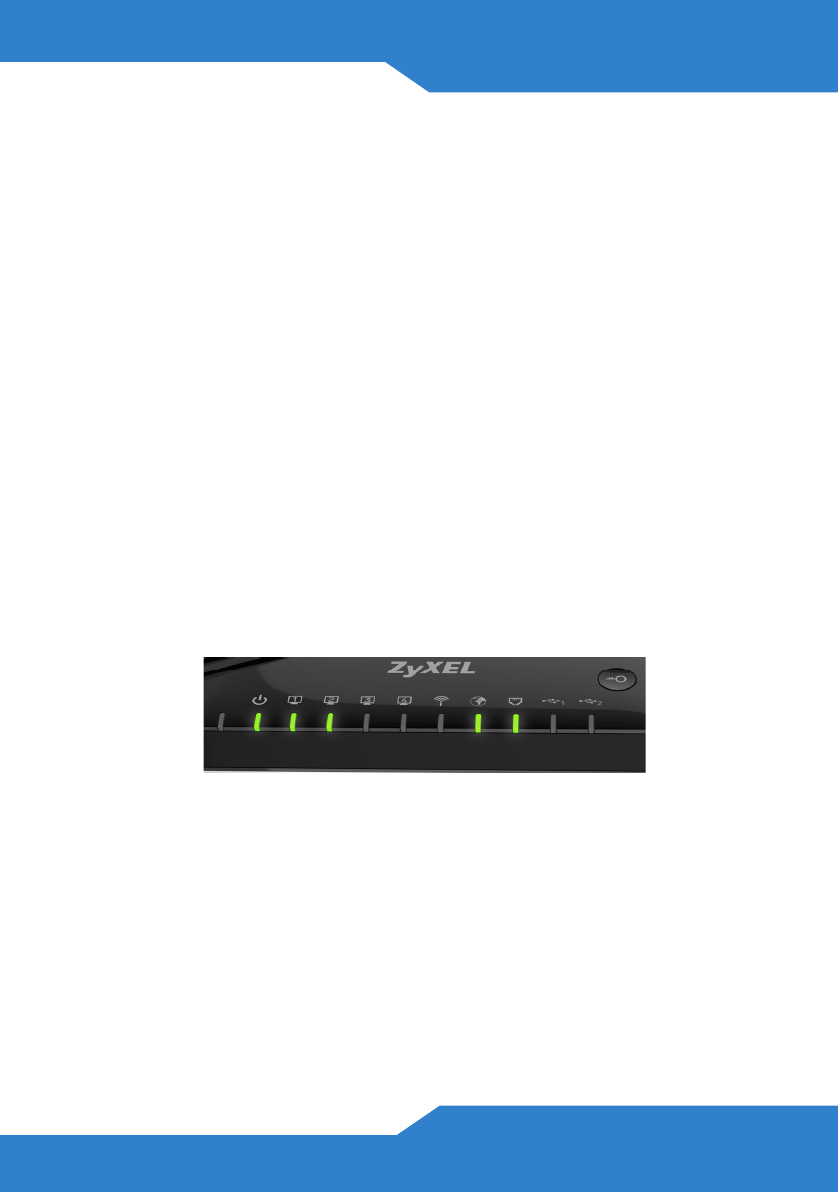
39
ITALIANO
2. ETHERNET: se si desidera un collegamento cablato al P-660HNU-
F1, utilizzare un cavo Ethernet per collegare un computer a una di
queste porte per la configurazione iniziale e/o per l'accesso a
Internet.
3. USB 2.0: questa porta va utilizzata solo per collegare un dispositivo
di archiviazione USB, una stampante USB o un adattatore 3G al P-
660HNU-F1.
4. ANTENNE: fissare le antenne fornite con il prodotto.
5. POWER: utilizzare l'alimentatore fornito a corredo del P-660HNU-F1
per collegare questa presa a una sorgente di alimentazione
appropriata.
6. Posizionare il pulsante Power sulla posizione di accensione e
osservare i LED (spie luminose) sul pannello anteriore del P-
660HNU-F1.
• Il LED POWER lampeggia durante l'avvio e resta acceso una volta
che il P-660HNU-F1 è pronto.
• Il LED ETHERNET si accende se la porta ETHERNET
corrispondente è connessa correttamente. Se non si collega
correttamente un computer a questa porta, il LED ETHERNET non
si accende.
• Il LED WLAN/WPS è acceso quando la LAN wireless è pronta. Il
LED non si accende se la connessione Wireless è disattivata.

40
I LED ETHERNET e WLAN/WPS lampeggiano quando il P-660HNU-F1
sta inviando o ricevendo dati. Se il LED POWER non si accende durante
l'avvio, provare a spegnere il P-660HNU-F1, controllare bene i
collegamenti e attendere qualche secondo e poi riaccenderlo. Se l'errore
persiste, è possibile che vi sia un problema hardware e che occorra
rivolgersi al venditore.
Configurazione dell'accesso a
Internet
I LED DSL e INTERNET sono accesi se è presente un accesso a
Internet. Aprire il browser e visitare la pagina www.zyxel.com. Potrebbe
comparire la richiesta di immettere nome utente e password.
Se una o entrambi questi LED non sono accesi, provare a spegnere il P-
660HNU-F1, a controllare bene i collegamenti, attendere qualche
secondo e poi riaccenderlo. Se il LED DSL non è acceso, rivolgersi al
proprio service provider. Se il LED DSL è acceso ma il LED INTERNET
non lo è, occorre entrare nella configurazione del proprio accesso a
Internet utilizzando lo Strumento di configurazione Web (vedere pagina
45).
Configurazione di una
connessione wireless
Per configurare una connessione wireless con il P-660HNU-F1, adottare
uno dei metodi seguenti:
1. Utilizzare il SSID wireless (nome della rete) e la chiave di crittografia
WPA-PSK se il dispositivo non ha il logo WPS (vedere pagina 41).

41
ITALIANO
2. Utilizzare il pulsante WPS/WLAN se il proprio dispositivo wireless ha
il logo WPS (Wi-Fi Protected Setup) (vedere pagina 44)
Configurazione di una connessione wireless
utilizzando le informazioni presenti
sull'etichetta
La funzione wireless del P-660HNU-F1 è attivata per impostazione
predefinita. Tenere premuto il pulsante WLAN/WPS sul pannello
anteriore del P-660HNU-F1 per 1 secondo per attivare/disattivare questa
funzione.
Per aggiungere un client wireless alla rete, utilizzare le impostazioni che
si trovano sul pannello posteriore del P-660HNU-F1, che sono:
1. Fare clic con il pulsante destro del mouse sull'icona dell'adattatore
wireless che appare in basso a destra della schermata del computer.
Scegliere View Available Wireless Networks (visualizza reti
wireless disponibili).
SSID: Zy_private_R9XP9P
WPA2-PSK: 7WC3R7TVKWK3R
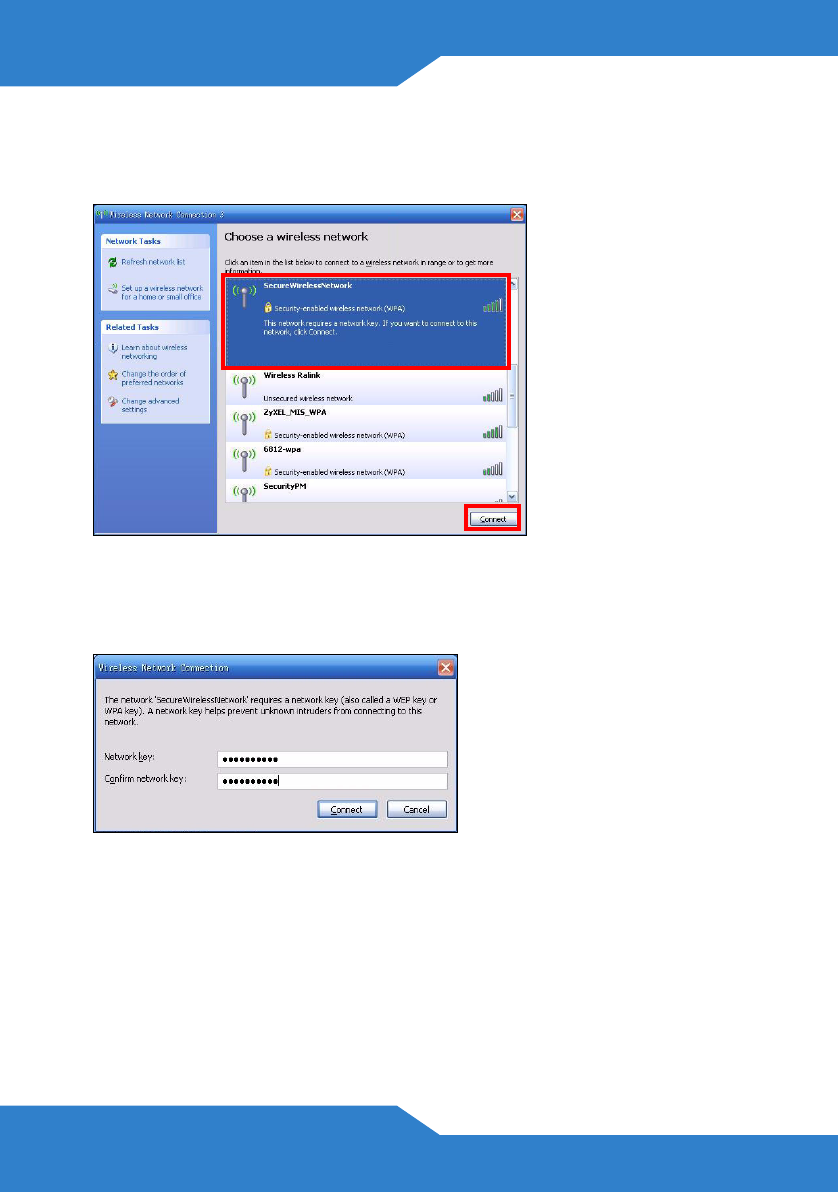
42
2. Selezionare il nome SSID del P-660HNU-F1 e fare clic su Connect
(connetti) (A). Il SSID "SecureWirelessNetwork" presentato in questo
documento è un esempio.
3. Viene richiesto di immettere una password. Immettere la chiave di
crittografia WPA-PSK che si trova sul pannello posteriore del P-
660HNU-F1 e fare clic su Connect (connetti).
4. Il computer potrebbe impiegare alcuni minuti per connettersi alla rete
wireless.
A

43
ITALIANO
5. Ora dovrebbe essere attiva una connessione wireless sicura al P-
660HNU-F1.
Se non è possibile connettersi al P-660HNU-F1 via wireless,
controllare di aver selezionato l’SSID corretto e di aver
immesso correttamente la chiave di sicurezza (Key). Se il
problema persiste, controllare se il LED WLAN/WPS sul
pannello anteriore è acceso.
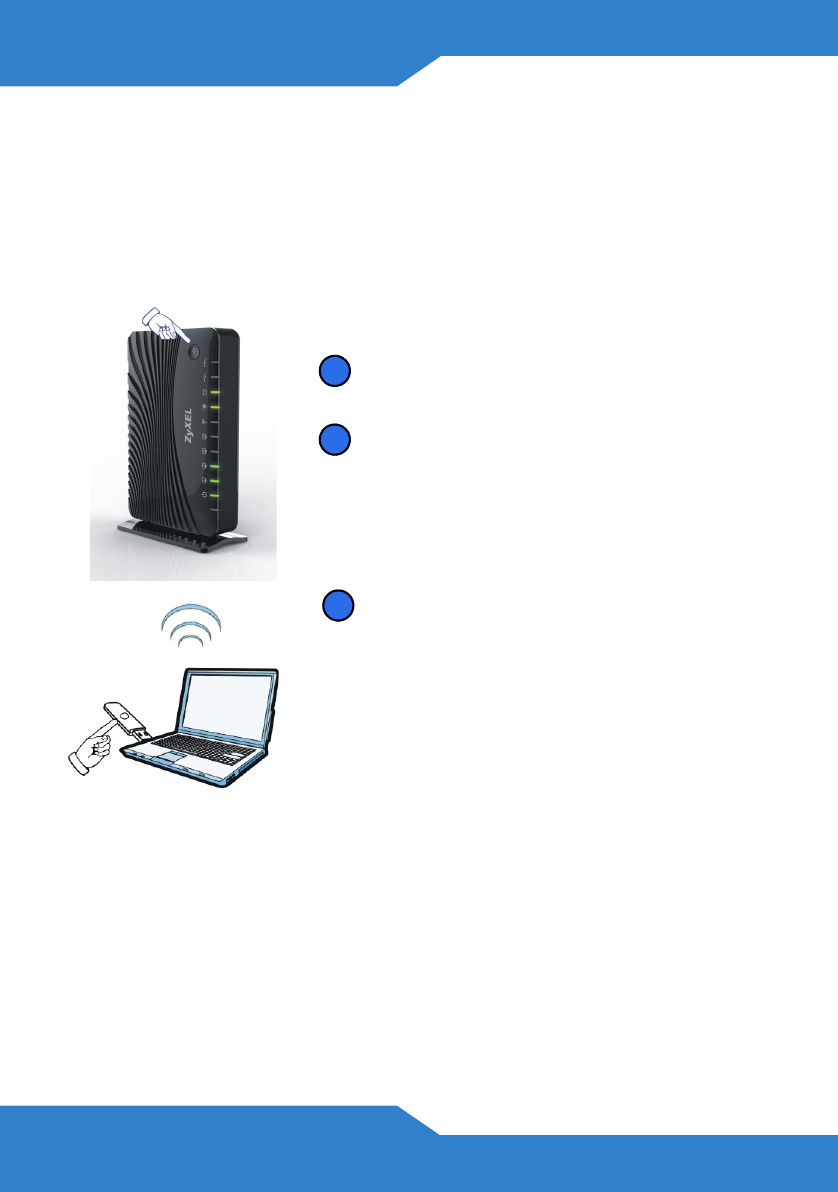
44
Configurazione di una connessione wireless
utilizzando WPS
Attenersi alle istruzioni seguenti per aggiungere un dispositivo
compatibile WPS alla rete wireless utilizzando il pulsante WLAN/WPS.
WPS va utilizzato un dispositivo alla volta con il P-660HNU-F1.
Posizionare i dispositivi che si desidera
collegare uno accanto all'altro.
Tenere premuto il pulsante WLAN/WPS
sul P-660HNU-F1 per più di 5 secondi
per attivare/disattivare la funzione
WPS.
Il LED WLAN/WPS lampeggia.
Premere il pulsante WPS di un
dispositivo compatibile entro 2 minuti
dalla pressione del pulsante sul P-
660HNU-F1.
Il LED WLAN/WPS del P-660HNU-F1
resta acceso quando il dispositivo è
connesso.
1
2
3
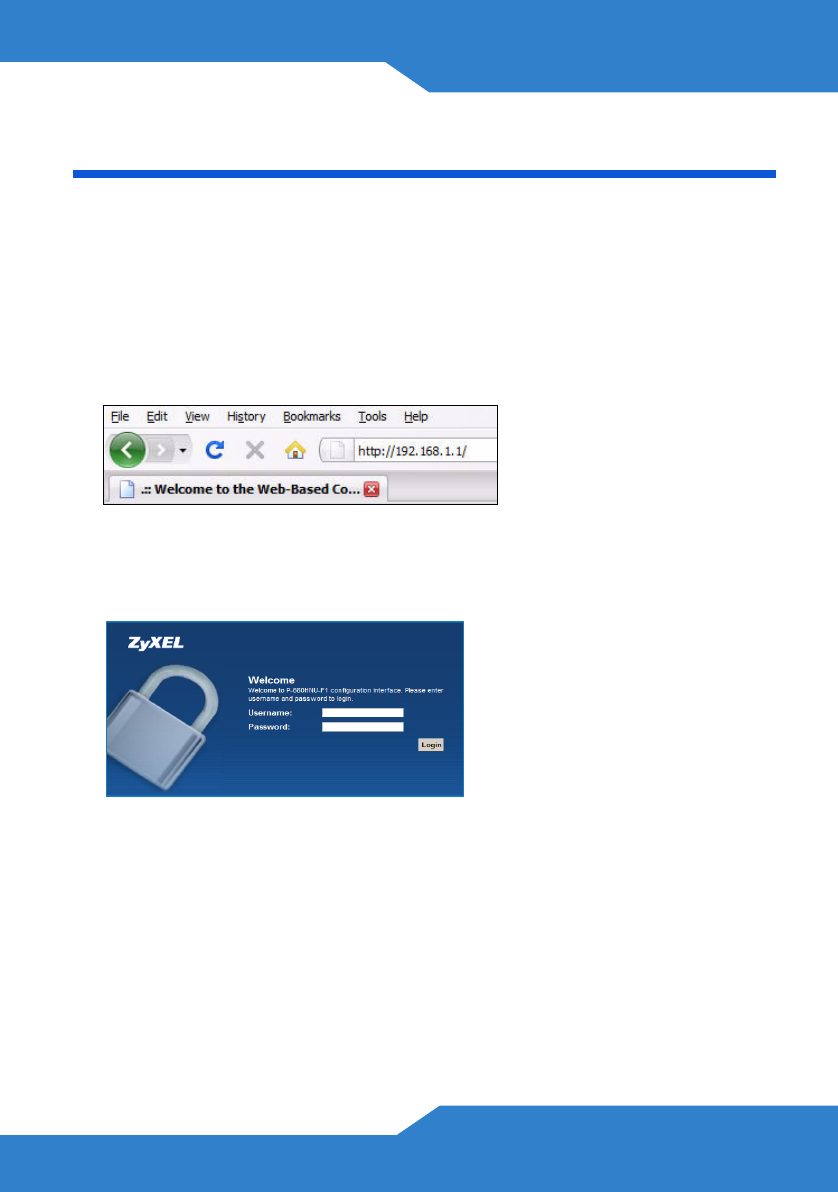
45
ITALIANO
Strumento di configurazione Web
Lo Strumento di configurazione Web è uno strumento per il browser che
consente di configurare il P-660HNU-F1. Per poter utilizzare questo
strumento, il computer e il P-660HNU-F1 devono trovarsi nello stesso
intervallo di indirizzi IP.
1. Avviare il browser e digitare http://192.168.1.1 (l'indirizzo IP
predefinito di P-660HNU-F1) nel campo dell'indirizzo.
2. Per accedere come amministratore, immettere il nome utente admin
e la password 1234 (default). Per accedere come utente, immettere il
nome utente user e la password 1234. Fare clic su Login (accedi).
Se la schermata di accesso non viene aperta, assicurarsi di
abilitare le finestre di pop-up, i JavaScript e il Java.
Impostare inoltre l'acquisizione automatica dell'indirizzo IP
da un server DHCP da parte del computer. Vedere la Guida
utente per i dettagli.

46
3. Se il LED INTERNET è spento, configurare manualmente la
connessione a Internet. Fare clic su Network Setting (impostazioni
di rete), quindi scegliere Broadband (banda larga) e fare clic su Add
new WAN Interface (Network Setting > Broadband > Add new
WAN Interface) (Impostazione di rete > Banda larga > Aggiungi
nuova interfaccia WAN).
• Selezionare la modalità Internet (Routing) e l'incapsulamento
(PPPoE) utilizzati dal proprio ISP.
• Immettere il nome utente dell'account e la relativa password.
• Immettere il proprio indirizzo IP statico e il server DNS se questi
non vengono assegnati automaticamente al proprio account.
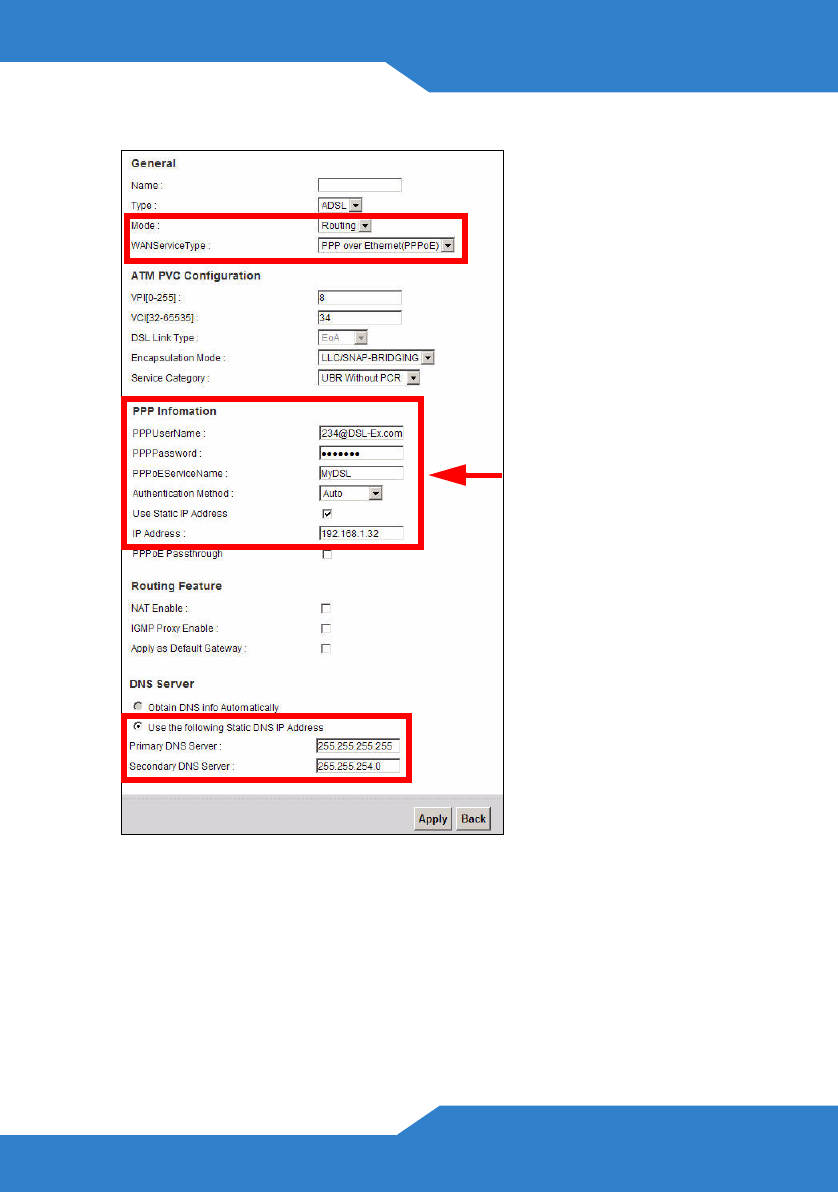
47
ITALIANO
Fare clic su Apply (applica).
• Per configurare l'accesso wireless aprire Network Setting
(impostazioni di rete)> Wireless.
• Per configurare la funzionalità di condivisione file USB, aprire
Network Setting > Home Networking > File Sharing
(Impostazione di rete > Rete domestica > Condivisione file).
Internet
Account

48
• Per configurare la funzionalità di server di stampa USB, aprire
Network Setting > Home Networking > Print Server
(Impostazione di rete > Rete domestica > Server di stampa).
• Se si dispone di un account 3G e si desidera configurare le
impostazioni 3G, aprire Network Setting > Broadband > 3G
Backup (Impostazione di rete > Banda larga > Connessione di
riserva 3G)
• Per configurare WPS utilizzando un PIN (Personal Identification
Number) e lo Strumento di configurazione Web, aprire Network
Setting (impostazioni di rete) > Wireless > WPS
Consultare la Guida dell'utente per ulteriori dettagli su queste e su altre
funzionalità del P-660HNU-F1
Visualizzazione delle certificazioni di un prodotto
1. Aprire la pagina www.zyxel.com.
2. Selezionare il prodotto dall'elenco di riepilogo a discesa nella
Home Page di ZyXEL per passare alla pagina del prodotto in
questione.
3. Selezionare da questa pagina la certificazione che si desidera
visualizzare.
Federal Communications Commission Statement
This device complies with FCC Rules Part 15. Operation is subject to the following
two conditions:
‧ This device may not cause harmful interference, and
‧ This device must accept any interference received, including interference that
may cause undesired operation.
This equipment has been tested and found to comply with the limits for a class B
digital device, pursuant to Part 15 of the Federal Communications Commission (FCC)
rules. These limits are designed to provide reasonable protection against harmful
interference in a residential installation. This equipment generates, uses, and can
radiate radio frequency energy and, if not installed and used in accordance with the
instructions, may cause harmful interference to radio communications. However,
there is no guarantee that interference will not occur in a particular installation. If this
equipment does cause harmful interference to radio or television reception, which can
be determined by turning the equipment off and on, the user is encouraged to try to
correct the interference by one or more of the following measures:
‧ Reorient or relocate the receiving antenna.
‧ Increase the separation between the equipment and receiver.
‧ Connect the equipment into an outlet on a circuit different from that to which the
receiver is connected.
‧ Consult the dealer or an experienced radio/TV technician for help.
The use of a shielded-type power cord is required in order to meet FCC emission
limits and to prevent interference to the nearby radio and television reception. It is
essential that only the supplied power cord be used. Use only shielded cables to
connect I/O devices to this equipment. You are cautioned that changes or
modifications not expressly approved by the party responsible for compliance could
void your authority to operate the equipment.
Note:
Any changes or modifications not expressly approved by the grantee of this device
could void the user's authority to operate the equipment.
RF exposure warning
This equipment complies with FCC radiation exposure limits set forth for an
uncontrolled environment. This equipment must be installed and operated in
accordance with provided instructions and the antenna(s) used for this transmitter
must be installed to provide a separation distance of at least 20 cm from all persons
and must not be co-located or operating in conjunction with any other antenna or
transmitter. End-users and installers must be provided with antenna installation
instructions and transmitter operating conditions for satisfying RF exposure
compliance.

ENGLISH DEUTSCH ESPAÑOL FRANÇAIS
Green Product Declaration
RoHS Directive 2002/95/EC
Green Product Declaration
RoHS Directive 2002/95/EC
Declaración de Producto Ecológico
Directiva RoHS 2002/95/EC
Déclaration de Produit Green
Directive RoHS 2002/95/EC
WEEE Directive 2002/96/EC
(WEEE: Waste Electrical and Electronic
Equipment)
2003/108/EC
WEEE Directive 2002/96/EC
(WEEE: Waste Electrical and Electronic
Equipment)
2003/108/EC
Directiva REEE 2002/96/EC
(REEE : Residuos de Equipos
Eléctricos y Electrónicos)
2003/108/EC
Directive DEEE 2002/96/EC
(DEEE : Déchets des Equipements
Electriques et Electroniques)
2003/108/EC
Declaration Signature:
Name/Title: Alan Cho / Quality Assurance Director
Date (yyyy/mm/dd): 2009/3/24
Unterschrift des Erklärenden:
Name/Titel: Alan Cho / Quality Assurance Director
Datum (JJJJ/MM/TT): 2009/3/24
Firma de declaración:
Nombre/Título: Alan Cho / Quality Assurance
Director
Fecha (aaaa/mm/dd): 2009/3/24
Signature de la déclaration :
Nom/Titre : Alan Cho / Quality Assurance Director
Date (aaaa/mm/jj) : 2009/3/24
ITALIANO NEDERLANDS SVENSKA
Dichiarazione Green Product
Direttiva RoHS 2002/95/CE
Productmilieuverklaring
RoHS-richtlijn 2002/95/EC
Miljödeklaration
RoHS Direktiv 2002/95/EC
Direttiva RAEE 2002/96/CE
(RAEE: Rifiuti di Apparecchiature
Elettriche ed Elettroniche)
2003/108/CE
AEEA-richtlijn 2002/96/EC
(AEEA: Afgedankte Elektrische en
Elektronische Apparaten)
2003/108/EC
WEEE Direktiv 2002/96/EC
(WEEE: hantering av elektriskt och
elektroniskt avfall)
2003/108/EC
Firma dichiarazione:
Nome/titolo: Alan Cho / Quality Assurance Director
Data (aaaa/mm/gg): 2009/3/24
Verklaringshandtekening:
Naam/titel: Alan Cho / Quality Assurance Director
Datum(jjjj/mm/dd): 2009/3/24
Deklaration undertecknad av:
Namn/Titel: Alan Cho / Quality Assurance Director
Datum (åååå/mm/dd): 2009/3/24